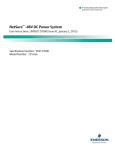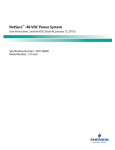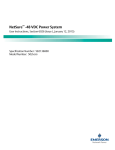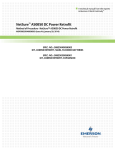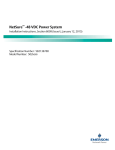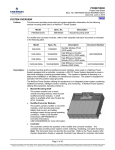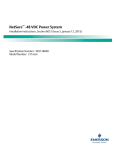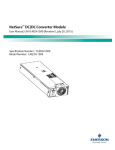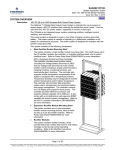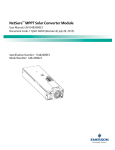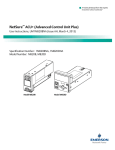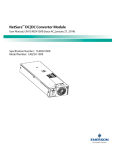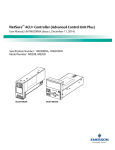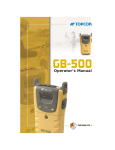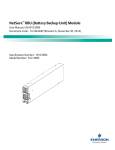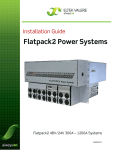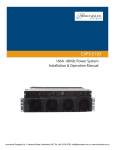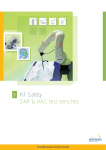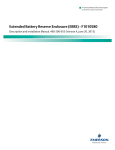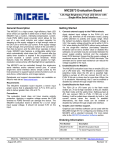Download NetSure™ -48V DC Power System
Transcript
NetSure™ -48V DC Power System User Instructions, UM582127000 (Issue AH, February 17, 2015) Specification Number: 582127000 Model Number: 721NPBB Main Bay Supplemental Bay (E/W Spec. No. 588705000 Module Mounting Shelves) Main Bay Supplemental Bay (E/W Spec. No. 588705300 Module Mounting Shelves) NetSure™ -48V DC Power System User Instructions, UM582127000 (Issue AH, February 17, 2015) This page is intentionally blank. Spec. No: 582127000 Model No: 721NPBB Code: UM582127000 Issue AH, February 17, 2015 NetSure™ -48V DC Power System User Instructions, UM582127000 (Issue AH, February 17, 2015) Table of Contents Admonishments Used in this Document ................................................................................................................ ii Important Safety Instructions .............................................................................................................................. iii General Safety ........................................................................................................................................................iii Voltages .................................................................................................................................................................iii Battery ...................................................................................................................................................................iii Personal Protective Equipment (PPE).......................................................................................................................iv Hazardous Voltage .................................................................................................................................................iv Handling Equipment Containing Static Sensitive Components .................................................................................iv Static Warning ...................................................................................................................................................... v System Overview .................................................................................................................................................. 1 Customer Documentation Package ......................................................................................................................... 1 System Description ................................................................................................................................................. 1 Operating Procedures ........................................................................................................................................... 2 Controller, Rectifiers, and Converters ...................................................................................................................... 2 ESTOP Function ...................................................................................................................................................... 2 Controller Battery Charge Current Limit Feature ...................................................................................................... 2 Local Controls and Indicators .................................................................................................................................. 3 Maintenance ....................................................................................................................................................... 10 System Maintenance Procedures .......................................................................................................................... 10 Adding a Rectifier or Converter Module to an Existing Module Mounting Shelf Spec. No. 588705000 ..................... 10 Adding a Rectifier or Converter Module to an Existing Module Mounting Shelf Spec. No. 588705300 ..................... 10 Installing a Field Expansion Module Mounting Shelf Spec. No. 588705000 ............................................................. 12 Installing a Field Expansion Module Mounting Shelf Spec. No. 588705300 ............................................................. 16 Reconfiguring a Dual Voltage Distribution Panel .................................................................................................... 19 Changing the Controller’s LVD Control Level for a Contactor.................................................................................. 28 Adding a Supplemental Bay in the Field ................................................................................................................. 28 Troubleshooting and Repair ................................................................................................................................ 28 Contact Information ............................................................................................................................................. 28 Controller, Rectifiers, and Converters .................................................................................................................... 28 Controller Configuration ....................................................................................................................................... 28 System Troubleshooting Information .................................................................................................................... 28 Replacement Information ..................................................................................................................................... 29 Replacement Procedures ...................................................................................................................................... 29 NetPerform™ Optimization Services ................................................................................................................... 59 Spec. No: 582127000 Model No: 721NPBB [i] Code: UM582127000 Issue AH, February 17, 2015 NetSure™ -48V DC Power System User Instructions, UM582127000 (Issue AH, February 17, 2015) Admonishments Used in this Document DANGER! Warns of a hazard the reader will be exposed to that will likely result in death or serious injury if not avoided. (ANSI, OSHA) Danger Warning Caution WARNING! Warns of a potential hazard the reader may be exposed to that could result in death or serious injury if not avoided. This admonition is not used for situations that pose a risk only to equipment, software, data, or service. (ANSI) CAUTION! Warns of a potential hazard the reader may be exposed to that could result in minor or moderate injury if not avoided. (ANSI, OSHA) This admonition is not used for situations that pose a risk only to equipment, data, or service, even if such use appears to be permitted in some of the applicable standards. (OSHA) ALERT! Alerts the reader to an action that must be avoided in order to protect equipment, software, data, or service. (ISO) Alert ALERT! Alerts the reader to an action that must be performed in order to prevent equipment damage, software corruption, data loss, or service interruption. (ISO) Alert FIRE SAFETY! Informs the reader of fire safety information, reminders, precautions, or policies, or of the locations of fire-fighting and fire-safety equipment. (ISO) Fire Safety SAFETY! Informs the reader of general safety information, reminders, precautions, or policies not related to a particular source of hazard or to fire safety. (ISO, ANSI, OSHA) Safety Spec. No: 582127000 Model No: 721NPBB [ii] Code: UM582127000 Issue AH, February 17, 2015 NetSure™ -48V DC Power System User Instructions, UM582127000 (Issue AH, February 17, 2015) Important Safety Instructions General Safety Danger DC Input Voltages DANGER! YOU MUST FOLLOW APPROVED SAFETY PROCEDURES. Danger Performing the following procedures may expose you to hazards. These procedures should be performed by qualified technicians familiar with the hazards associated with this type of equipment. These hazards may include shock, energy, and/or burns. To avoid these hazards: a) The tasks should be performed in the order indicated. DC Output and Battery Voltages b) Remove watches, rings, and other metal objects. c) Prior to contacting any uninsulated surface or termination, use a voltmeter to verify that no voltage or the expected voltage is present. Check for voltage with both AC and DC voltmeters prior to making contact. Danger d) Wear eye protection. e) Use double insulated tools appropriately rated for the work to be performed. f) For 400V DC input systems, do not work on an energized system without full arc flash and PPE protection. Voltages AC Input Voltages Danger Danger DANGER! This system may operate from AC input voltage capable of producing fatal electrical shock. AC input power must be completely disconnected from the branch circuits wiring used to provide power to the system before any AC electrical connections are made. Follow local lockout/tagout procedures to ensure upstream branch circuit breakers remain de-energized during installation. DO NOT apply AC input power to the system until all electrical connections have been completed and checked. Spec. No: 582127000 Model No: 721NPBB DANGER! This system may operate from 400V DC input voltage capable of producing fatal electrical shock. DC input power must be completely disconnected from the branch circuits wiring used to provide power to the system before any DC electrical connections are made. Follow local lockout/tagout procedures to ensure upstream branch circuit breakers remain de-energized during installation. DO NOT apply DC input power to the system until all electrical connections have been completed and checked. [iii] DANGER! This system produces DC Power and may have a battery source connected to it. Although the DC voltage is not hazardously high, the rectifiers/converters and/or battery can deliver large amounts of current. Exercise extreme caution not to inadvertently contact or have any tool inadvertently contact an output terminal or battery terminal or exposed wire connected to an output terminal or battery terminal. NEVER allow a metal object, such as a tool, to contact more than one termination or battery terminal at a time, or to simultaneously contact a termination or battery terminal and a grounded object. Even a momentary short circuit can cause sparking, explosion, and injury. DANGER! Follow local lockout/tagout procedures to ensure DC branch circuit protection devices remain deenergized during installation at loads, as required. Battery Warning Warning WARNING! Correct polarity must be observed when connecting battery leads. WARNING! Special safety precautions are required for procedures involving handling, installing, and servicing batteries. Observe all battery safety precautions in this manual and in the battery instruction manual. These precautions should be followed implicitly at all times. Code: UM582127000 Issue AH, February 17, 2015 NetSure™ -48V DC Power System User Instructions, UM582127000 (Issue AH, February 17, 2015) Warning FOR THESE REASONS, IT IS OF CRITICAL IMPORTANCE THAT YOU READ THESE INSTRUCTIONS AND FOLLOW THEM EXACTLY. WARNING! A battery can present a risk of electrical shock and high short circuit current. Servicing of batteries should be performed or supervised only by properly trained and qualified personnel knowledgeable about batteries and the required precautions. WHEN WORKING WITH LEAD-ACID BATTERIES: The following precautions should be observed when working on batteries: • Remove watches, rings, and other metal objects. • Eye protection should be worn to prevent injury from accidental electrical arcs. • Use certified and well maintained insulated tools. Use double insulated tools appropriately rated for the work to be performed. Ensure that wrenches with more than one working end have only one end exposed. • Do not lay tools or metal parts on top of batteries. • Disconnect charging source prior to connecting or disconnecting battery terminals. • Risk of explosion if battery is replaced with an incorrect type or if polarity is reversed. When replacing batteries, replace with the same manufacturer and type, or equivalent. • Dispose of used batteries according to the instructions provided with the batteries. Do not dispose of batteries in a fire. They may explode. • ALWAYS FOLLOW THE BATTERY MANUFACTURER’S RECOMMENDATIONS AND SAFETY INSTRUCTIONS. In addition to the hazard of electric shock, gas produced by batteries can be explosive and sulfuric acid can cause severe burns. Do not open or mutilate batteries. Released electrolyte is harmful to the skin and eyes, and is toxic. If electrolyte comes into contact with skin, the affected area should be washed immediately with large amounts of water. Danger DANGER! This equipment may be used in conjunction with lead-acid batteries. Working near lead-acid batteries is dangerous! • Batteries contain sulfuric acid. • Batteries generate explosive gases during normal operation. Systems containing batteries should never be installed in an airtight room or space. Only install in a ventilated environment. • Spec. No: 582127000 Model No: 721NPBB Alert • Wear complete protection for eyes, face, hands, and clothing. Examples are safety goggles or face shield, a rubber apron and gloves. • If battery acid enters your eye, immediately flush your eye with running cold water for at least 15 minutes. Get medical attention immediately. • If battery acid contacts skin or clothing, wash immediately with soap and water. ALERT! Performing maintenance and/or troubleshooting procedures may interrupt power to the loads, if battery reserve is not sufficient. Personal Protective Equipment (PPE) Danger DANGER! ARC FLASH AND SHOCK HAZARD. Appropriate PPE and tools required when working on this equipment. An appropriate flash protection boundary analysis should be done determine the “hazard/risk” category, and to select proper PPE. This product is intended only for installation in a Restricted Access Location. Only authorized and properly trained personnel should be allowed to install, inspect, operate, or maintain the equipment. Do not work on LIVE parts. If required to work or operate live parts, obtain appropriate Energized Work Permits as required by the local authority, per NFPA 70E “Standard for Electrical Safety in the Workplace”. Hazardous Voltage Danger DANGER! Hazard of electrical shock. More than one disconnect may be required to de-energize the system before servicing. Handling Equipment Containing Static Sensitive Components Alert Batteries are an energy source that can produce high amounts of electrical current. [iv] ALERT! Installation or removal of equipment containing static sensitive components requires careful handling. Before handling any equipment containing static sensitive components, read and follow the instructions contained on the Static Warning Page. Code: UM582127000 Issue AH, February 17, 2015 NetSure™ -48V DC Power System User Instructions, UM582127000 (Issue AH, February 17, 2015) Static Warning This equipment contains static sensitive components. The warnings listed below must be observed to prevent damage to these components. Disregarding any of these warnings may result in personal injury or damage to the equipment. 1. Strictly adhere to the procedures provided in this document. 2. Before touching any equipment containing static sensitive components, discharge all static electricity from yourself by wearing a wrist strap grounded through a one megohm resistor. Some wrist straps, such as Emerson Network Power Part Number 631810600, have a built-in one megohm resistor; no external resistor is necessary. Read and follow wrist strap manufacturer’s instructions outlining use of a specific wrist strap. 3. Do not touch traces or components on equipment containing static sensitive components. Handle equipment containing static sensitive components only by the edges that do not have connector pads. 4. After removing equipment containing static sensitive components, place the equipment only on conductive or anti-static material such as conductive foam, conductive plastic, or aluminum foil. Do not use ordinary Styrofoam™ or ordinary plastic. 5. Store and ship equipment containing static sensitive components only in static shielding containers. 6. If necessary to repair equipment containing static sensitive components, wear an appropriately grounded wrist strap, work on a conductive surface, use a grounded soldering iron, and use grounded test equipment. Spec. No: 582127000 Model No: 721NPBB [v] Code: UM582127000 Issue AH, February 17, 2015 NetSure™ -48V DC Power System User Instructions, UM582127000 (Issue AH, February 17, 2015) This page is intentionally blank. Spec. No: 582127000 Model No: 721NPBB [vi] Code: UM582127000 Issue AH, February 17, 2015 NetSure™ -48V DC Power System User Instructions, UM582127000 (Issue AH, February 17, 2015) System Overview Customer Documentation Package This document (UM582127000) provides User Instructions for NetSure™ -48V DC Power System Model 721NPBB, Spec. No. 582127000. The complete Customer Documentation Package consists of… NetSure -48V DC Power System Quick Start Guide: QS582127000 • NetSure™ -48V DC Power System Installation Instructions: IM582127000 ™ NetSure™ ACU+ Controller User Instructions: UM1M820BNA (AC Input Voltage Systems) or UM1M820DNA400 (DC Input Voltage Systems) • Power System Quick Start Guide: QS582127000 • Power System Installation Instructions: IM582127000 • Power System User Instructions: UM582127000 • ACU+ Controller User Instructions: UM1M820BNA • NCU Controller User Instructions: UM1M830BNA • ACU+ Controller User Instructions: UM1M820DNA400 • Power System “System Application Guide”: SAG582127000 • Module Mounting Shelf Power Data Sheet: PD588705000 • • Four different sizes of distribution cabinets are available to accept from one (1) to four (4) distribution panels. A variety of distribution panels are available that provide load distribution, battery distribution, and dual voltage load distribution for use with +24V converters. These distribution panels are configured to accept either bullet nose type circuit breakers and TPS/TLS fuseholders, TPH fuses, TPL-B fuses, or GJ/218 circuit breakers. The distribution cabinet may be equipped with low voltage load disconnect (LVLD), low voltage battery disconnect (LVBD), and manual battery disconnect. Module Mounting Shelf Power Data Sheet: PD588705300 • Rectifier Instructions: UM1R482000E3 • Converter Instructions: UM1C48241500 Controller The controller controls the operation of the rectifier and converter modules. The controller also provides power system control, metering, monitoring, and alarm functions. ACU+ (Advanced Control Unit Plus): The ACU+ Controller provides power system control (including optional low voltage battery disconnect (LVBD) and low voltage load disconnect (LVLD) control), rectifier control (including a charge control function), converter control, metering functions, monitoring functions, and local/remote alarm functions. The controller also supports NCU Controller 2nd Ethernet Port Add-On Kit Instructions: IM559252 Spec. No: 582127000 Model No: 721NPBB The NetSure™ 721NPBB DC Power System is a complete integrated power system containing -48V DC rectifiers or converters, optional +24V DC converters, intelligent control, metering, monitoring, and distribution. The system always includes a minimum of one distribution cabinet, which provides DC distribution through fuses and/or circuit breakers. The distribution cabinet is factory mounted in the relay rack or shipping brackets specified when ordered. USB Drive with All Customer Documentation Converter Instructions: UM1C400483500E Also provided on the USB drive is a controller configuration drawing and the controller configuration files loaded into the controller as shipped. Distribution Cabinet NetSure™ NCU Controller User Instructions: UM1M830BNA (AC Input Voltage Systems) • • This system consists of the following components. NetSure™ NCU Controller User Manual Rectifier Instructions: UM1R483500E Engineering Drawings This power system is designed to power a load while charging a positive grounded battery. This power system is capable of operating in a batteryless installation or off battery for maintenance purposes. The power system is designed for operation with the positive output grounded. NetSure™ ACU+ Controller User Manual • • -48V DC @ up to 4000 Amperes Power System • • NCU Controller 2nd Ethernet Port Retrofit Kit Instructions: IM559251 System Description NetSure™ -48V DC Power System Installation Manual • • [1] Code: UM582127000 Issue AH, February 17, 2015 NetSure™ -48V DC Power System User Instructions, UM582127000 (Issue AH, February 17, 2015) rectifier temperature compensation if the system is equipped with a temperature probe(s). Temperature probe(s) may also be designated to monitor ambient temperature and/or battery temperature. The controller also provides data acquisition, system alarm management, and advanced battery and energy management. The controller contains an LCD display and keypad for local access. The controller provides an Ethernet port and comes with comprehensive webpages for remote access. The controller has SNMP capability for remote system management. The controller supports software upgrade via its USB port. Refer to the ACU+ Controller Instructions (UM1M820BNA or UM1M820DNA400) for more information. NCU (NetSure Control Unit): The NCU Controller provides power system control (including optional low voltage battery disconnect (LVBD) and low voltage load disconnect (LVLD) control), rectifier control (including a charge control function), converter control, metering functions, monitoring functions, and local/remote alarm functions. The controller also supports rectifier temperature compensation if the system is equipped with a temperature probe(s). Temperature probe(s) may also be designated to monitor ambient temperature and/or battery temperature. The controller also provides data acquisition, system alarm management, and advanced battery and energy management. The controller contains a color LCD display and keypad for local access. The controller provides an Ethernet port and comes with comprehensive webpages for remote access. The controller has SNMP capability for remote system management. The controller supports software upgrade via its USB port. Refer to the NCU Controller Instructions (UM1M830BNA) for more information. Module Mounting Shelf (Spec. No. 588705300) The system may contain one or more Spec. No. 588705300 module mounting shelves, each of which houses rectifier modules and optional DC-DC converter modules. Refer to Power Data Sheet PD588705300 for more information. • The system contains rectifier modules, which provide load power, battery float current, and battery recharge current during normal operating conditions. Refer to the Rectifier Instructions (UM1R482000E3) for more information. • • Rectifier Modules (for use in Spec. No. 588705000) The system may contain rectifier modules; which provide load power, battery float current, and battery recharge current during normal operating conditions. Refer to the Rectifier Instructions (UM1R483500E) for more information. • Converter Modules (for use in Spec. No. 588705000) The system may contain converter modules; which provide load power, battery float current, and battery recharge current during normal operating conditions. Refer to the Converter Instructions (UM1C400483500E) for more information. Spec. No: 582127000 Model No: 721NPBB Optional DC-DC Converter Modules (for use in Spec. No. 588705300) Where +24V DC load power is also required, DC-DC converter modules are available. Refer to the Converter Instructions (UM1C48241500) for more information. Operating Procedures Controller, Rectifiers, and Converters For operation instructions on these units, refer to the following documents. Module Mounting Shelf (Spec. No. 588705000) The system may contain one or more Spec. No. 588705000 module mounting shelves, each of which houses up to six (6) rectifier modules or six (6) converter modules. Refer to Power Data Sheet PD588705000 for more information. Rectifier Modules (for use in Spec. No. 588705300) • ACU+ Controller Instructions (UM1M820BNA or UM1M820DNA400) • NCU Controller Instructions (UM1M830BNA) • Rectifier Instructions (UM1R483500E or UM1R482000E3) • Converter Instructions (UM1C400483500E or UM1C48241500) ESTOP Function If an ESTOP switch is wired to the IB2 Controller Interface Board, customer-furnished system ground applied to terminal DI8+ activates the ESTOP function. The ESTOP function shuts down and locks out the rectifiers or 400V DC input converters, opens the LVD’s, and shuts down the optional -48V to +24V DC converters. When the ESTOP signal is removed, LVD’s close (if battery present) and -48V to +24V DC converters restart. To restart the rectifiers or 400V DC input converters; turn input power to the rectifiers/converters OFF, wait 30 seconds or more (until the LEDs on the module extinguish), then turn input power to the rectifiers/converters ON. Controller Battery Charge Current Limit Feature Functionality: After a failure of the input source (commercial AC or DC) or when some battery cells are permanently damaged, the current to the batteries can be quite extensive. To avoid overheating or further damages to the battery, the controller can [2] Code: UM582127000 Issue AH, February 17, 2015 NetSure™ -48V DC Power System User Instructions, UM582127000 (Issue AH, February 17, 2015) Local Controls and Indicators be programmed to limit the battery current to a preset level by limiting the charging voltage of the rectifiers/converters. Should the battery current still exceed a higher preset value, an alarm is issued. Refer to the Controller, Rectifier, and Converter Instructions for descriptions of the local controls and indicators located on these units. The controller limits the current going to the batteries based on the “Battery Current Limit” set point which is a percentage of the battery capacity in C10. For example, 0.1C10 would mean 10% of the battery capacity. Refer to the ACU+ Instructions (UM1M820BNA or UM1M820DNA400) or NCU Instructions (UM1M830BNA) to program this feature. Battery charge current is limited to the value set in the controller, as long as battery voltage is above 47V DC. Spec. No: 582127000 Model No: 721NPBB [3] Refer to this section for descriptions of the local controls and indicators located on the circuit cards installed in the distribution cabinet. Circuit Card Locations Refer to Figure 1. Code: UM582127000 Issue AH, February 17, 2015 NetSure™ -48V DC Power System User Instructions, UM582127000 (Issue AH, February 17, 2015) Figure 1. Circuit Card Locations 4-Row Cabinet Shown, Others Similar (Front Door Removed in Illustration for Clarity) Optional EIB (Main Bay Only) (Extended Interface Board) (located on inside side panel) IB2 (Main Bay Only) (Interface Board) (located on inside side panel) Optional SM-DU+ and Shunt Interface Board Controller (Main Bay) SM-DU (Supplemental Bays) Mounting Position Optional LVD Inhibit Switch (factory installed if option specified) Optional LVD Driver Lite Circuit Card Spec. No: 582127000 Model No: 721NPBB Optional LVD Driver Circuit Card OR Optional Manual Battery Disconnect Circuit Card (Main Bay Only) [4] System Interface Circuit Card Code: UM582127000 Issue AH, February 17, 2015 NetSure™ -48V DC Power System User Instructions, UM582127000 (Issue AH, February 17, 2015) System Interface Circuit Card The system interface circuit card contains test points to externally monitor bay voltage and bay load. Refer to Figure 2. Figure 2. System Interface Circuit Card J7 J1 J2 J3 TB2 J8 J4 Bay Load Shunt Scale List 21, 1-Row Cabinet 800A / 25mV 32A per mV List 22, 2-Row Cabinet 2000A / 25mV 80A per mV List 23, 3-Row Cabinet 2500A / 25mV 100A per mV 1 1 1 1 List 24, 4-Row Cabinet 2500A / 25mV 100A per mV J10 J5 TB1 TP1 TP2 TP3 TP4 TP1 (+) and TP2 (-) Bay Voltage Monitoring Spec. No: 582127000 Model No: 721NPBB TP3 (+) and TP4 (-) Bay Load Shunt Monitoring [5] Code: UM582127000 Issue AH, February 17, 2015 NetSure™ -48V DC Power System User Instructions, UM582127000 (Issue AH, February 17, 2015) Optional LVD Driver Circuit Card The optional LVD driver circuit card installed in the main bay contains an LVD inhibit switch and indicator. Refer to Figure 3. LVD driver circuit cards are required for 2-, 3-, or 4-row distribution cabinets that contain three or more LVD contactors (LVBD and/or LVLD); or if the distribution cabinet is equipped with an LVBD contactor rated 1200A or higher. Caution Warning CAUTION! If the switch is returned to the ON (normal) position when low voltage disconnect alarms are active, a low voltage disconnection will occur. WARNING! While the LVD inhibit switch is in the OFF (inhibit) position, a low voltage disconnection will not occur if battery or load voltage decreases below the low voltage disconnect setpoint. For maximum battery protection, this switch should NOT be left in the OFF (inhibit) position. Figure 3. Optional LVD Driver Circuit Card J6 J5 J9 J3 J4 J2 J1 J7 S1 LVD Inhibit Active Indicator Illuminates when the low voltage disconnect circuit has been disabled through the use of the LVD Inhibit switch. Spec. No: 582127000 Model No: 721NPBB Switch and indicator located on circuit card installed in Main Bay onl y. Note: The UP position will not close the LVBD contactor if the battery is manually disconnected using the LVD Inhibit Switch Manual Battery Disconnect Switch. Momentary UP / Middle / Down Momentary UP Position: Closes all LVD Contactors (inhibit mode). Middle Position: OFF (Controller DOES NOT control LVD’s) (inhibit mode). DOWN Position: ON (Controller controls LVD’s). [6] Code: UM582127000 Issue AH, February 17, 2015 NetSure™ -48V DC Power System User Instructions, UM582127000 (Issue AH, February 17, 2015) Optional LVD Driver Lite Circuit Card The optional LVD driver lite circuit card installed in the main bay contains an LVD inhibit switch and indicator. Refer to Figure 4. LVD driver lite circuit cards are required for distribution cabinets that contain two LVLD contactors or one LVLD contactor and one LVBD contactor. LVBD contactor must be rated at 600A or lower. CAUTION! If the switch is returned to the ON (normal) position when low voltage disconnect alarms are active, a low voltage disconnection will occur. Caution Warning WARNING! While the LVD inhibit switch is in the OFF (inhibit) position, a low voltage disconnection will not occur if battery or load voltage decreases below the low voltage disconnect setpoint. For maximum battery protection, this switch should NOT be left in the OFF (inhibit) position. Figure 4. Optional LVD Driver Lite Circuit Card J3 J1 J2 Switch and indicator located on circuit card installed in Main Bay onl y. S1 LVD Inhibit Active Indicator Illuminates when the low voltage disconnect circuit has been disabled through the use of the LVD Inhibit switch. Spec. No: 582127000 Model No: 721NPBB Note: The UP position will not close the LVBD contactor if the battery is manually disconnected using the Manual Battery Disconnect Switch. LVD Inhibit Switch Momentary UP / Middle / Down Momentary UP Position: Closes all LVD Contactors (inhibit mode). Middle Position: OFF (Controller DOES NOT control LVD’s) (inhibit mode). DOWN Position: ON (Controller controls LVD’s). [7] Code: UM582127000 Issue AH, February 17, 2015 NetSure™ -48V DC Power System User Instructions, UM582127000 (Issue AH, February 17, 2015) Optional Manual Battery Disconnect Circuit Card (Main Bay Only) The optional manual battery disconnect circuit card contains a manual battery disconnect switch and indicator. Refer to Figure 5. Figure 5. Optional Manual Battery Disconnect Circuit Card (Main Bay Only) J2 J1 S1 Manual Battery Disconnect Switch Manual Battery Disconnect Active Indicator Illuminates if the Battery Disconnect Contactor has been manually disconnected (placed in open position). Momentary UP / Middle / Momentary Down Momentary UP Position: Closes (latches in close position) the Battery Disconnect Contactor. Middle Position: Normal Operation. Momentary DOWN Position: Opens (latches in open position) the Battery Disconnect Contactor. Momentarily place switch in the UP position to close the contactor. Spec. No: 582127000 Model No: 721NPBB [8] Code: UM582127000 Issue AH, February 17, 2015 NetSure™ -48V DC Power System User Instructions, UM582127000 (Issue AH, February 17, 2015) SM-DU Circuit Card The SM-DU is used in supplemental bays in place of a controller. The SM-DU monitors the bay and reports to the controller. The controller sends commands to the SM-DU to fulfill battery management and load control functions according to the received data. There are three (3) status and alarm indicators located on the SM-DU. The functions of these indicators (from top to bottom as shown in the illustration) are as shown in Table 1. Refer to Figure 6 for location. Table 1. SM-DU Indicators Indicator Normal State Fault State Alarm (Red) Off On A critical or major alarm. Alarm (Yellow) Off On A minor alarm. Off SM-DU is non-operational. Operation (Green) Fault Cause A 1/3Hz flashing indicates the SM-DU is being identified by the Controller. A 1Hz flashing indicates a communication failure. On Flashing Figure 6. SM-DU Circuit Card Spec. No: 582127000 Model No: 721NPBB [9] Code: UM582127000 Issue AH, February 17, 2015 NetSure™ -48V DC Power System User Instructions, UM582127000 (Issue AH, February 17, 2015) Adding a Rectifier or Converter Module to an Existing Module Mounting Shelf Spec. No. 588705300 Maintenance System Maintenance Procedures It is recommended to perform the maintenance procedures listed in Table 2 every 6-months to ensure continual system operation. Table 2. Maintenance Procedures to be Performed at 6-Month Intervals PROCEDURE Check ventilation openings for obstructions such as dust, papers, manuals, etc. Inspect and tighten all installer's connections. REFERENCED IN COMPLETED ( √) To increase system current capacity, a rectifier module can easily be added to an existing module mounting shelf Spec. No. 588705300 that contains an empty rectifier module mounting position. Likewise, to increase subsystem capacity a DC-DC converter module can be added to a module mounting shelf Spec. No. 588705300 that contains an empty converter module mounting position. Rectifier and converter modules can be inserted or removed with power applied (hot swappable). -- IM582127000, “Making Electrical Connections” section. Rectifiers modules can be installed in any mounting position of each module mounting shelf. Converters modules can be installed in any of the three far right mounting positions of each module mounting shelf (as viewed from the front). See Figure 7. Note: Each rectifier and converter module locks into the module mounting shelf by means of a latch located on the bottom of the module. The latch and module handle are interactive. Pushing the handle up into the module’s front panel causes the latch to extend to the locking position; pulling the handle down out from the module’s front panel causes the latch to retract. See Figure 7. Note: This table may be reproduced as necessary to record and document system performance. Adding a Rectifier or Converter Module to an Existing Module Mounting Shelf Spec. No. 588705000 To increase system current capacity, a rectifier or converter module can easily be added to an existing module mounting shelf Spec. No. 588705000 that contains an empty rectifier or converter module mounting position. Warning PROCEDURE It is recommended that the current limit point be checked whenever a rectifier or converter module is added to or removed from a 588705000 shelf in the power system. Refer to “Checking the Controller’s Current Limit Point after Adding or Removing a Rectifier Module or Converter Module” on page 28. 1. Unpack the modules. 2. Note the model number located on the front of each module. Model numbers starting with the letter “R” are rectifier modules. Model numbers starting with the letter “C” are converter modules. 3. Place the module into an unoccupied mounting position without sliding it in completely. Rectifiers modules can be installed in any mounting position of each module mounting shelf. Converters modules can be installed in any of the three far right mounting positions of each module mounting shelf (as viewed from the front). See Figure 7. 4. Loosen the captive screw on the module’s handle. Pull the handle down out from the module’s front panel (this will also retract the latch mechanism). See Figure 7. 5. Push the module completely into the shelf. The rectifier or converter module being added is assigned by the controller the lowest available identification number. If desired, you can change the identification number. Refer to the ACU+ Instructions (UM1M820BNA or UM1M820DNA400) or NCU Instructions (UM1M830BNA) for a procedure. • • For rectifier module installation instructions, refer to Rectifier Instructions (UM1R483500E). For converter module installation instructions, refer to Converter Instructions (UM1C400483500E). Spec. No: 582127000 Model No: 721NPBB WARNING! To prevent damage to the latching mechanism, ensure the handle is in the open position when installing or removing a module. NEVER hold the handle in the closed position when installing a module into a shelf. [10] Code: UM582127000 Issue AH, February 17, 2015 NetSure™ -48V DC Power System User Instructions, UM582127000 (Issue AH, February 17, 2015) 6. Push the handle up into the module’s front panel. This will lock the module securely to the shelf. Tighten the captive screw on the handle. 7. Repeat the above steps for each module being installed in the system. 8. After the modules are physically installed in the mounting shelf(s), they are ready for operation immediately after power is supplied to them. Note: It is recommended that the current limit point be checked whenever a rectifier is added to or removed from the power system. Refer “Checking the Controller’s Current Limit Point after Adding or Removing a Rectifier Module or Converter Module” on page 28. Note: The rectifier or converter being added is assigned by the controller the lowest available identification number. If desired, you can change the identification number. Refer to the ACU+ Instructions (UM1M820BNA or UM1M820DNA400) or NCU Instructions (UM1M830BNA) for a procedure. Figure 7. Installing Rectifier and Converter Modules in a Spec. No. 588705300 Shelf Module Mounting Shelf(s) Front View Rectifier Mounting Positions Rectifier or Converter Mounting Positions Rectifier or Converter Module Captive Screw Handle Model Number Label (R48-2000e3 Rectifier) (C48/24-1500 Converter) Latch Spec. No: 582127000 Model No: 721NPBB [11] Code: UM582127000 Issue AH, February 17, 2015 NetSure™ -48V DC Power System User Instructions, UM582127000 (Issue AH, February 17, 2015) Installing a Field Expansion Module Mounting Shelf Spec. No. 588705000 Danger Hardware build-up for these connections are: 1/4-20 x 1" bolt, 1/4" Belleville lock washer, 1/4" flat washer. DANGER! Adhere to the “Important Safety Instructions” presented at the front of this document. Install the Belleville lock washer so the concave side is towards the busbar. Torque all connections to 60 in-lbs. Note: Refer to Figure 8 and Figure 9 as this procedure is performed. If installing a second expansion module mounting shelf, 1/4-20 nuts (included) are required in lieu of the 1/4-20 x 1” bolts (see Figure 8). PROCEDURE 1. Install the expansion module mounting shelf directly below the bottom-most module mounting shelf in the rack. Use the mounting hardware provided in the expansion busbar kit. 4. Disconnect the cable coming from the distribution cabinet from the bottom connector on the bottom-most existing module mounting shelf. Hardware build-up is: 12-24 x 3/4" screw and flat washer, (1) set per side. 12-24 x 3/4" screw and ground washer, (1) set per side. 5. Connect the bottom connector on the bottom-most existing module mounting shelf to the top connector on the expansion module mounting shelf. Note: Install the ground washers so the teeth make 6. Connect the cable disconnected in step 4) (coming from distribution cabinet) to the bottom connector on expansion module mounting shelf. 7. Replace the rear covers removed in step 2) above. 8. Refer to the Power System Installation Instructions (IM582127000) and connect AC or DC input power to the expansion module mounting shelf. 9. Refer to the Rectifier or Converter Instructions and install rectifier or converter modules into the expansion module mounting shelf as required. contact with the metal on the mounting angles. Torque all screws to 65 in-lbs. 2. On the rear of the expansion module mounting shelf and the existing shelf installed directly above it, remove the rear shield that covers the output busbars. Note: Apply electrical anti-oxidizing compound to busbar mating surfaces before performing the next step. 3. Secure the existing shelf’s busbars to the expansion shelf’s mating busbars with the supplied interconnect busbars and hardware. Spec. No: 582127000 Model No: 721NPBB [12] Code: UM582127000 Issue AH, February 17, 2015 NetSure™ -48V DC Power System User Instructions, UM582127000 (Issue AH, February 17, 2015) Figure 8. Installing a Field Expansion Module Mounting Shelf Spec. No. 588705000 (cont’d on next page) Front View (Install Expansion Module Mounting Shelf) Spec. No: 582127000 Model No: 721NPBB Rear View (Remove Rear Shield from Module Mounting Shelf and Shelf Above It) [13] Code: UM582127000 Issue AH, February 17, 2015 NetSure™ -48V DC Power System User Instructions, UM582127000 (Issue AH, February 17, 2015) Figure 8. Installing a Field Expansion Module Mounting Shelf Spec. No. 588705000 (cont’d from previous page) Rear View (Install Output Busbars from Kit) Completed View 1st Expansion Shelf 2nd Expansion Shelf Spec. No: 582127000 Model No: 721NPBB [14] Code: UM582127000 Issue AH, February 17, 2015 NetSure™ -48V DC Power System User Instructions, UM582127000 (Issue AH, February 17, 2015) Figure 9. Controller CAN Bus, Module Mounting Shelf Spec. No. 588705000 Distribution Cabinet Wire Harness Slate and Slate/White Wires Brown and Brown/White Wires These cables are factory connected. Existing Module Mounting Shelf These cables are factory connected. Existing Module Mounting Shelf These cables are factory connected. Existing Module Mounting Shelf Disconnect cable coming from distribution cabinet from this connector on bottom-most existing shelf, then connect to the top connector on the expansion shelf. Expansion Module Mounting Shelf Connect the cable disconnected above (coming from distribution cabinet) to bottom connector on expansion shelf. Spec. No: 582127000 Model No: 721NPBB Exploded View Shown to Illustrate Wire Connections Only [15] Code: UM582127000 Issue AH, February 17, 2015 NetSure™ -48V DC Power System User Instructions, UM582127000 (Issue AH, February 17, 2015) Installing a Field Expansion Module Mounting Shelf Spec. No. 588705300 Danger module mounting shelf and the studs on the shelf above it. Secure these busbars to the expansion module mounting shelf with the hardware provided with the expansion module mounting shelf. Secure these busbars to the shelf above the expansion module mounting shelf with the hardware previously removed. Torque to 60 in-lbs. DANGER! Adhere to the “Important Safety Instructions” presented at the front of this document. Note: Refer to Figure 10 and Figure 11 as this procedure is performed. Hardware build-up for these connections are: M6 Nut, M6 Belleville lock washer, M6 flat washer. PROCEDURE 1. Remove the busbar rear shield from the existing module mounting shelves. Remove the cut-out panel from the busbar rear shield by gently bending the panel until it snaps from the busbar rear shield. 2. Remove the hardware from the lowest module mounting shelf’s -48V, return, and +24V (if present) busbars. 3. Install the expansion module mounting shelf directly below the bottom-most module mounting shelf in the rack. Use the mounting hardware provided with the expansion module mounting shelf. Hardware build-up is: 12-24 x 3/4" screw and flat washer, (1) set per side. 12-24 x 3/4" screw and ground washer, (1) set per side. 6. Disconnect the cable coming from the distribution cabinet from the connector on the bottom-most existing module mounting shelf and connect this cable to the same connector on the expansion module mounting shelf. 7. Connect the open connector on the bottom-most existing module mounting shelf to the open connector on the expansion module mounting shelf. 8. Re-install the rear busbar shield previously removed from the existing module mounting shelf. Re-install the rear busbar shield previously removed from the expansion module mounting shelf. 9. Refer to the Power System Installation Instructions (IM582127000) and connect AC input power to the expansion module mounting shelf. Note: Install the ground washers so the teeth make contact with the metal on the mounting angles. Torque all screws to 65 in-lbs. 4. Remove the busbar rear shield from the expansion module mounting shelf. 10. Refer to the Power System Installation Instructions (IM582127000) and install rectifier and converter modules into the expansion module mounting shelf as required. Note: Apply electrical anti-oxidizing compound to busbar mating surfaces before performing the next step. 5. Install the busbars provided with the expansion module mounting shelf between the studs on the expansion Spec. No: 582127000 Model No: 721NPBB [16] Code: UM582127000 Issue AH, February 17, 2015 NetSure™ -48V DC Power System User Instructions, UM582127000 (Issue AH, February 17, 2015) Figure 10. Installing a Field Expansion Module Mounting Shelf Spec. No. 588705300 1. Remove busbar rear shield from existing rectifier/converter shelves. Remove the cut-out panel from the busbar rear shield. Busbar Rear Shield Cut-Out Panel 2. Remove hardware from the lowest module mounting shelf’s -48V, return, and +24V (if present) busbars. Rear 3. Install the expansion module mounting shelf into the rack. 4. Remove busbar rear shield from expansion module mounting shelf. Front Rear 5. Install the busbars provided with the expansion module mounting shelf between the shelves. Torque to 60 in-lbs. 6. Re-install the rear busbar shields previously removed. Spec. No: 582127000 Model No: 721NPBB [17] Code: UM582127000 Issue AH, February 17, 2015 NetSure™ -48V DC Power System User Instructions, UM582127000 (Issue AH, February 17, 2015) Figure 11. Controller CAN Bus, Module Mounting Shelf Spec. No. 588705300 Distribution Cabinet Wire Harness Exploded View Shown to Illustrate Wire Connections Only Slate and Slate/White Wires Existing Module Mounting Shelf Brown and Brown/White Wires These connectors are factory connected. Rear View Factory provided jumper to bring connectors to same side of shelf. Existing Module Mounting Shelf These connectors are factory connected. Rear View Factory provided jumper to bring connectors to same side of shelf. Existing Module Mounting Shelf These connectors are factory connected. Rear View X Factory provided jumper to bring connectors to same side of shelf. Disconnect cable coming from distribution cabinet from this connector on bottom-most existing shelf, then connect to the same connector on the expansion shelf. Expansion Module Mounting Shelf Rear View Now connect these two connectors together. Spec. No: 582127000 Model No: 721NPBB Factory provided jumper to bring connectors to same side of shelf. [18] Code: UM582127000 Issue AH, February 17, 2015 NetSure™ -48V DC Power System User Instructions, UM582127000 (Issue AH, February 17, 2015) Reconfiguring a Dual Voltage Distribution Panel Perform the following procedure to reconfigure a dual voltage distribution panel (List DA, DB, DC, DD) to move distribution positions from one voltage to the other. Danger DANGER! Performing this procedure exposes service personnel to battery potential. Exercise extreme caution not to inadvertently contact or have any tool inadvertently contact any energized electrical termination. Note: Save all removed hardware. Hardware will be re-used. Removing the Distribution Panel PROCEDURE 1. Performing this procedure may activate external alarms. Do one of the following. If possible, disable these alarms. If these alarms cannot be easily disabled, notify the appropriate personnel to disregard any future alarms associated with this system while the procedure is being performed. 2. Open the distribution cabinet’s front door by turning the latch in the counterclockwise position. 3. Remove the plastic shield covering the circuit breakers and/or fuseholders on the distribution panel to be removed by loosening the screws holding the shield and sliding the shield upwards. 4. Record circuit breaker and/or fuse positions and sizes. 5. Remove circuit breakers and/or fuseholders. 6. Label the load leads. 7. Disconnect all load leads from the circuit breaker and/or fuse positions. 8. Disconnect all load return leads from the ground busbar. 9. Refer to Figure 12 and remove the hardware securing the +24V jumper leads. Insulate and tie back these leads. 10. Refer to Figure 12 and locate the in-line FA/CBA connector located near the back of the distribution panel. Separate the connector halves. 11. Refer to Figure 12 and remove the hardware securing the distribution panel’s ground busbar to the distribution cabinet’s busbar. 12. Refer to Figure 12 and remove the hardware securing the distribution panel’s system load distribution busbar to the distribution cabinet’s busbar. 13. Refer to Figure 12 and remove the hardware securing the distribution panel to the distribution cabinet. Remove the distribution panel from the distribution cabinet. Spec. No: 582127000 Model No: 721NPBB [19] Code: UM582127000 Issue AH, February 17, 2015 NetSure™ -48V DC Power System User Instructions, UM582127000 (Issue AH, February 17, 2015) Figure 12. Removing/Installing the Distribution Panel 10-32 x 5/8” Screw #10 Flat Washer Torque to 31 in-lbs. Distribution Panel Hardware Ground Busbar Hardware 1/4-20 x 1” Bolt 1/4” Belleville Lock Washer 1/4” Flat Washer Torque to 60 in-lbs. List DB Dual Voltage Distribution Panel (List DA, DC, DD similiar) 10-32 x 5/8” Screw #10 Flat Washer Torque to 31 in-lbs. Distribution Panel Hardware System Load Distribution Busbar Hardware 1/4-20 x 1” Bolt 1/4” Belleville Lock Washer 1/4” Flat Washer Torque to 60 in-lbs. In-Line FA/CBA Connector Front Components removed in illustration for clarity only. +24V Jumpers 1/4-20 x 5/8 Bolt 1/4” Lock Washer 1/4” Flat Washer Torque to 75 in-lbs. List DB Dual Voltage Distribution Panel (List DA, DC, DD similiar) Spec. No: 582127000 Model No: 721NPBB [20] Code: UM582127000 Issue AH, February 17, 2015 NetSure™ -48V DC Power System User Instructions, UM582127000 (Issue AH, February 17, 2015) Reworking the Distribution Panel Introduction You can reconfigure the distribution panel to swap +24V distribution positions for -48V distribution positions, and vice versa, in groups of four. The resulting assembly can have (5) +24V and (16) -48V, (9) +24V and (12) -48V, (13) +24V and (8) -48V, or (17) +24V and (4) -48V positions. You do this by removing the subsystem input power busbar and associated input lead busbars, then moving the appropriate distribution device busbar and associated distribution device lead busbars left or right in increments of four (4) positions, then re-installing the subsystem input power busbar and associated input lead busbars. The distribution devices alarm spring most also be appropriately moved. Refer to the following procedures to reconfigure the distribution panel. Figure 13. Reworking the Distribution Panel Introduction List DB Dual Voltage Distribution Panel (List DA, DC, DD similar) Rear Move +24V Input Lead Busbars 4-Positions Left or Right in Increments of Four Positions Move +24V Input Power Busbar 4-Positions Left or Right in Increments of Four Positions Distribution Device Lead Busbars Distribution Device Lead Busbars Front Move +24V Input Power Busbar 4-Positions Left or Right in Increment of Four Positions Move +24V Distribution Device Busbar Right Spec. No: 582127000 Model No: 721NPBB OR [21] Move -48V Distribution Device Busbar Left Code: UM582127000 Issue AH, February 17, 2015 NetSure™ -48V DC Power System User Instructions, UM582127000 (Issue AH, February 17, 2015) Removing the +24V Input Power Busbar and Input Lead Busbars PROCEDURE 1. From the front of the distribution panel, remove the three bolts and hardware from the +24V input power busbar. 2. From the rear of the distribution panel, remove the two bolts and hardware from the +24V input power busbar. 3. Remove the +24V input power busbar from the distribution panel. Set aside for later re-installation. 4. Remove the three +24V input lead busbars from the distribution panel. Refer to Figure 14 and press in the tab to release a +24V input lead busbar. Slide the +24V input lead busbar up and out of the distribution panel. Repeat for all three busbars. Set aside for later re-installation. Figure 14. Removing the +24V Input Power Busbar and Input Lead Busbars List DB Dual Voltage Distribution Panel (List DA, DC, DD similar) +24V Input Lead Busbars Rear Press in Tabs to Release Input Lead Busbars +24V Input Power Busbar +24V Input Lead Busbars Front +24V Input Power Busbar Spec. No: 582127000 Model No: 721NPBB [22] Code: UM582127000 Issue AH, February 17, 2015 NetSure™ -48V DC Power System User Instructions, UM582127000 (Issue AH, February 17, 2015) Moving the Distribution Device Busbar and Distribution Lead Busbars Left or Right PROCEDURE 1. Determine how you are reconfiguring the distribution panel (adding -48V or +24V distribution positions). Locate the distribution device busbars and distribution device lead busbars to be moved. 2. From the front of the distribution panel, remove the two screws and hardware securing the appropriate distribution device busbar(s). The busbar(s) are located to the left or to the right of the open space created when the +24V input power busbar was removed in the previous procedure. 3. From the rear of the distribution panel, remove the two bolts and hardware securing the distribution device link busbar(s) between the distribution device busbar(s) to be moved and the one adjacent to it. 4. Slide the distribution device busbar(s) three (3) positions to the left or to the right. 5. From the front of the distribution panel, re-install the two screws and hardware to secure the distribution device busbar(s) just moved. Torque as indicated in Figure 15. 6. From the rear of the distribution panel, re-install the distribution device link busbar(s) between the distribution device busbar(s) just moved and the one adjacent to it with the two bolts and hardware previously removed. Apply anti-oxidizing compound to busbar mating surfaces. Torque as indicated in Figure 15. 7. Remove the four distribution device lead busbars located above the position(s) of each of the distribution device busbar(s) were moved from. Refer to Figure 15 and press in the tab to release a distribution device lead busbar. Slide the distribution device lead busbar up and out of the distribution panel. Repeat for all distribution device lead busbars. 8. Remove the polarity labels from these positions. Turn over the polarity labels so the other polarity shows. Re-install the polarity labels to the left or right of the original position (into the positions the distribution device lead busbars will be moved to in the next step). 9. Re-install the distribution device lead busbars three (3) positions to the left or to the right of the original positions. Slide a distribution device lead busbar down and into the distribution panel. Repeat for all distribution device lead busbars. Spec. No: 582127000 Model No: 721NPBB [23] Code: UM582127000 Issue AH, February 17, 2015 NetSure™ -48V DC Power System User Instructions, UM582127000 (Issue AH, February 17, 2015) Figure 15. Moving the Distribution Device Busbar and Distribution Lead Busbars Left or Right List DB Dual Voltage Distribution Panel (List DA, DC, DD similar) Apply a thin coating of electrical anti-oxidizing compound to the mating surfaces of the busbars. 1/4-20 x 5/8 Bolt 1/4” Lock Washer 1/4” Flat Washer Torque to 75 in-lbs. Rear Press in Tabs to Release Distribution Device Lead Busbars Remove polarity label. Turn over polarity label so other polarity shows. Replace polarity label in relocated distribution positions. ibu Distr tion Move -48V Distribution Device Busbar(s) 3 Positions Left OR Move +24V Distribution Device Busbar(s) 3 Positions Right ars Busb Lead e ic Dev OR Front 6-32 x 3/4 Screw #6 Lock Washer #6 Flat Washer Torque to 11 in-lbs. Move +24V Distribution Device Busbar(s) 3 Positions Right Spec. No: 582127000 Model No: 721NPBB OR [24] Move -48V Distribution Device Busbar(s) 3 Positions Left Code: UM582127000 Issue AH, February 17, 2015 NetSure™ -48V DC Power System User Instructions, UM582127000 (Issue AH, February 17, 2015) Moving the Alarm Spring(s) Left or Right PROCEDURE 1. Located the alarm spring(s) and alarm spring link(s) to be moved. 2. From the rear of the distribution panel, remove the appropriate alarm spring link(s). 3. From the rear of the distribution panel, remove the screw(s) from the alarm spring(s) to be moved. Slide the alarm spring(s) three (3) positions to the left or to the right. Secure with the screw(s) just removed. Torque as indicated in Figure 16. 4. Re-install the alarm spring link(s) to the opposite side of the alarm spring(s) just moved and to the alarm spring adjacent to it. Torque as indicated in Figure 16. Figure 16. Moving the Alarm Spring(s) Left or Right List DB Dual Voltage Distribution Panel (List DA, DC, DD similar) Typical Before View Rear Exploded View 6-19 x 5/16 Screw Torque to 9.6 in-lbs. Rear Place Alarm Spring Link on Opposite Side Place Alarm Spring Link on Opposite Side 6-19 x 1/2 Screw Torque to 9.6 in-lbs. Move Alarm Spring(s) 3 Positions Right OR Move Alarm Spring(s) 3 Positions Left Typical After View Rear Spec. No: 582127000 Model No: 721NPBB [25] Code: UM582127000 Issue AH, February 17, 2015 NetSure™ -48V DC Power System User Instructions, UM582127000 (Issue AH, February 17, 2015) Re-Installing the +24V Input Power Busbar and Input Lead Busbars PROCEDURE 1. Re-install the +24V input lead busbars. Slide the +24V input lead busbars down and into the distribution panel in the mounting locations created when the distribution device lead busbars were moved in the previous procedure. 2. Re-install the +24V input power busbar into the distribution panel in the position created when the distribution device busbar in the previous procedure was moved. 3. From the front of the distribution panel, re-install the three bolts and hardware to secure the +24V input power busbar to the +24V input lead busbars. Torque as indicated in Figure 17. 4. From the rear of the distribution panel, re-install the two bolts and hardware to secure the +24V input power busbar. Torque as indicated in Figure 17. Figure 17. Re-Installing the +24V Input Power Busbar and Input Lead Busbars List DB Dual Voltage Distribution Panel (List DA, DC, DD similar) +24V Input Lead Busbars Apply a thin coating of electrical anti-oxidizing compound to the mating surfaces of the busbars. Enlarged View Rear Press in Tabs to Release Input Lead Busbars +24V Input Power Busbar 1/4-20 x 5/8 Bolt 1/4” Lock Washer 1/4” Flat Washer Torque to 75 in-lbs. +24V Input Lead Busbars Enlarged View Front Spec. No: 582127000 Model No: 721NPBB +24V Input Power Busbar 1/4-20 x 3/4 Bolt 1/4” Lock Washer 1/4” Flat Washer Torque to 75 in-lbs. [26] Code: UM582127000 Issue AH, February 17, 2015 NetSure™ -48V DC Power System User Instructions, UM582127000 (Issue AH, February 17, 2015) Moving the 24V/48V Label on the Distribution Device Cover to the New Position PROCEDURE 1. Move the polarity label on the distribution device cover right or left to align with the distribution positions moved in the previous procedures. Figure 18. Moving the 24V/48V Label on the Distribution Device Cover to the New Position List DB Dual Voltage Distribution Panel (List DA, DC, DD similar) Move this Label Left or Right as Required Replacing the Distribution Panel Note: In the following procedure, before making busbar-to-busbar connections, apply a thin coating of electrical anti-oxidizing compound to the mating surfaces of the busbars. PROCEDURE 2. Orient the distribution panel into the distribution cabinet, checking to ensure no wires are pinched. Replace the hardware securing the distribution panel to the distribution cabinet. Refer to Figure 12 for hardware build-up. Torque as indicated in Figure 12. 3. Reconnect the +24V jumper leads. Refer to Figure 12 for hardware build-up. Torque as indicated in Figure 12. 4. Replace the hardware securing the distribution panel’s system load distribution busbar to the distribution cabinet’s busbar. Refer to Figure 12 for hardware build-up. Torque as indicated in Figure 12. 5. Replace the hardware securing the distribution panel’s ground busbar to the distribution cabinet’s busbar. Torque as indicated in Figure 12. 6. Plug the in-line FA/CBA connector located near the back of the distribution panel into the mating connector half in the distribution cabinet. Refer to Figure 12. WARNING! In the next step, observe correct polarity; otherwise equipment damage will result. Warning 7. Reconnect the load return leads to the ground busbar. 8. Reconnect the load leads to the circuit breaker and/or fuse positions. 9. Replace the circuit breakers and/or fuseholders. 10. Replace the plastic shield covering the circuit breakers and/or fuseholders on the distribution panel. 11. Verify no circuit breaker/fuse alarms are active. 12. Close the distribution cabinet’s front door. Turn the latch clockwise to secure the door. 13. Ensure that there are no local or remote alarms active on the system. Spec. No: 582127000 Model No: 721NPBB [27] Code: UM582127000 Issue AH, February 17, 2015 NetSure™ -48V DC Power System User Instructions, UM582127000 (Issue AH, February 17, 2015) Changing the Controller’s LVD Control Level for a Contactor The controller has two available LVD control levels (LVD1 and LVD2). The level used to control a contactor is determined by which connector on the LVD circuit card its control leads are plugged into. To change the LVD control level for a contactor, simply switch which LVD connector it is plugged into (if an open connector is available) on the LVD circuit card. Refer to Figure 32and Figure 33 for connector location and function. Controller Configuration If any controller configuration settings were changed, refer to the ACU+ Instructions (UM1M820BNA or UM1M820DNA400) or NCU Instructions (UM1M830BNA) and save a copy of the configuration file. This file can be used to restore the controller settings, if required, at a later date. • Note: DO NOT change a Low Voltage Load Disconnect contactor to LVD Control Level 2 (LVD2) if the system is furnished with a Low Voltage Battery Disconnect contactor. Adding a Supplemental Bay in the Field Refer to the Power System Installation Instructions (IM582127000) for procedures detailing mounting and wiring of the supplemental bay. Supplied with the supplemental bay is a USB drive which contains a “SettingParam.run” file. Download this file into the controller to program the controller for use with the newly installed supplemental bay. Refer to the ACU+ Instructions (UM1M820BNA or UM1M820DNA400) or NCU Instructions (UM1M830BNA) for a download procedure. There are also labels located near the SM-DU and SM-DU+ in the supplemental bay that detail the controller’s settings for this bay. Once the controller has been programmed for the newly installed supplemental bay, refer to the ACU+ Instructions (UM1M820BNA or UM1M820DNA400) or NCU Instructions (UM1M830BNA) and save a copy of the “SettingParam.run” file. Troubleshooting and Repair Contact Information Support contact information is provided on the inside of the back cover of this document. Controller, Rectifiers, and Converters For troubleshooting and repair instructions on these units, refer to the following documents. • ACU+ Controller Instructions (UM1M820BNA or UM1M820DNA400) • NCU Controller Instructions (UM1M830BNA) • Rectifier Instructions (UM1R483500E or UM1R482000E3) • Converter Instructions (UM1C400483500E or UM1C48241500) Spec. No: 582127000 Model No: 721NPBB Note that provided on a USB drive furnished with the system is a controller configuration drawing (C-drawing) and the controller configuration files loaded into the controller as shipped. System Troubleshooting Information This system is designed for ease in troubleshooting and repair. The various indicators as described in “Local Controls and Indicators” on page 3 and in the Controller and Rectifier Instructions are designed to isolate failure to a specific element. Once the faulty element has been identified, refer to “Replacement Information” on page 29 and “Replacement Procedures” on page 29. Troubleshooting Alarm Conditions on the Controller The controller displays alarm conditions as listed in the “Available Alarms” or “Resolving Alarms” section of the controller’s User Manual. Programmable external alarm relays are also available. Refer to the System Installation Instructions (IM582127000) and the configuration drawing (C-drawing) supplied with your power system documentation for your alarm relay configurations. The controller’s Active Alarm and Alarm History submenus allow the User to view alarm details. Refer to the ACU+ Instructions (UM1M820BNA or UM1M820DNA400) or NCU Instructions (UM1M830BNA) to access these menus. Checking the Controller’s Current Limit Point after Adding or Removing a Rectifier Module or Converter Module If a rectifier module or converter module is added to the power system, the system current limit point will automatically increase by the percentage each existing rectifier or converter was set to provide prior to the addition. If a rectifier module or converter module is removed from the system (and the Rect Comm Fail or Conv Comm Fail alarm is reset), the current limit point will remain unchanged unless the capacity of the remaining rectifiers or converters is not sufficient to maintain the present current limit point. If that happens, the current limit point will automatically increase to the maximum (121% of the remaining rectifiers or converters). It is recommended that the current limit point be checked whenever a rectifier module or converter module is added to or removed from the power system. [28] Code: UM582127000 Issue AH, February 17, 2015 NetSure™ -48V DC Power System User Instructions, UM582127000 (Issue AH, February 17, 2015) When setting total rectifier or total converter current limit, the set point to each unit is the total set point divided by the number of units. For example, if the system contains five rectifiers and the current limit is set to 150 amps then each rectifier has a current limit set point of 30 amps. If one or more rectifiers or converters are removed or fail it will take several seconds for the individual set points to the remaining rectifiers or converters to be reset. In the example given, if one rectifier is removed the current limit set point will drop to 120 amps (30 amps times four remaining rectifiers) until the controller can send updated set points to the remaining rectifiers. This takes a couple communication cycles (several seconds) after which each rectifier would have a new set point of 37.5 amps for a total of 150 amps. The total current limit of the rectifiers and converters should not be set such that the loss of the redundant rectifiers or converters will cause this temporary set point to drop below the actual maximum expected load. If batteries are used on the rectifier output, the batteries should support the load until the current limit set points can be reestablished due to loss of a rectifier. Clearing a Converter Lost Alarm If the controller resets while a converter communications fail alarm is active, the converter communications fail alarm is replace with a converter lost alarm. Refer to the ACU+ Instructions (UM1M820BNA or UM1M820DNA400) or NCU Instructions (UM1M830BNA) for a procedure to clear the alarm. Replacement Information Replacement Assemblies When a trouble symptom is localized to a faulty rectifier module, converter module, controller, or system circuit card; that particular device or circuit card should be replaced in its entirety. No attempt should be made to troubleshoot or repair individual components on any rectifier module, converter module, controller, or circuit card. Refer to SAG582127000 (System Application Guide) for replacement part numbers. Refer to the ACU+ Instructions (UM1M820BNA or UM1M820DNA400) or NCU Instructions (UM1M830BNA) for a procedure. Replacement Cables Clearing a Rectifier Communications Fail Alarm after Removing a Rectifier If a rectifier module is removed from the system, a rectifier communications failure alarm is generated. If the rectifier module will not be replaced, the alarm should be cleared. Refer to SAG582127000 (System Application Guide) for replacement part numbers. Replacement Procedures Danger Refer to the ACU+ Instructions (UM1M820BNA or UM1M820DNA400) or NCU Instructions (UM1M830BNA) for a procedure. DANGER! Adhere to the “Important Safety Instructions” presented at the front of this document. Replacing a Rectifier or Converter Module (in a Spec. No. 588705000 Shelf) Refer to the Rectifier Instructions (UM1R483500E) or Converter User Instructions (UM1C400483500E) for a rectifier and converter module replacement procedure. Refer also to “System Troubleshooting Information” on page 28. Clearing a Converter Communications Fail Alarm after Removing a Converter If a converter module is removed from the system, a converter communications failure alarm is generated. If the converter module will not be replaced, the alarm should be cleared. The rectifier or converter module being replaced is assigned by the controller the lowest available identification number. If desired, you can change the identification number. Refer to the ACU+ Instructions (UM1M820BNA or UM1M820DNA400) or NCU Instructions (UM1M830BNA) for a procedure. Refer to the ACU+ Instructions (UM1M820BNA or UM1M820DNA400) or NCU Instructions (UM1M830BNA) for a procedure. Clearing a Rectifier Lost Alarm Replacing a Rectifier or Converter Module (in a Spec. No. 588705300 Shelf) If the controller resets while a rectifier communications fail alarm is active, the rectifier communications fail alarm is replace with a rectifier lost alarm. Refer to the Rectifier User Instructions (UM1R482000E3) or Converter User Instructions (UM1C48241500) for a rectifier and converter module replacement procedure. Refer also to “System Troubleshooting Information” on page 28. Refer to the ACU+ Instructions (UM1M820BNA or UM1M820DNA400) or NCU Instructions (UM1M830BNA) for a procedure to clear the alarm. Spec. No: 582127000 Model No: 721NPBB The rectifier or converter module being replaced is assigned by the controller the lowest available identification number. If desired, [29] Code: UM582127000 Issue AH, February 17, 2015 NetSure™ -48V DC Power System User Instructions, UM582127000 (Issue AH, February 17, 2015) you can change the identification number. Refer to the ACU+ Instructions (UM1M820BNA or UM1M820DNA400) or NCU Instructions (UM1M830BNA) for a procedure. Replacing a TPS/TLS Fuse Replacing the Controller Note: Refer to Figure 20 as this procedure is performed. PROCEDURE 1. Open the distribution cabinet’s front door by turning the latch in the counterclockwise position. 2. Remove the fuse carrier from the mounted fuseholder body by pulling it straight out. General 3. Remove the open fuse from the fuse carrier and replace it with the same type and rating. Replace distribution devices with the same type and rating. Refer to System Application Guide SAG582127000 for part numbers. 4. Replace the alarm fuse located in the front of the fuse carrier with the same type and rating. Ensure that a plastic safety cover is installed on the alarm fuse. 5. Push the fuse carrier securely back into the mounted fuseholder body. Note that a polarizing key on the bottom of the carrier prevents the carrier from being inserted upside down. 6. Verify no Fuse Alarms are active. 7. Close the distribution cabinet’s front door. Turn the latch clockwise to secure the door. Refer to the ACU+ Instructions (UM1M820BNA or UM1M820DNA400) or NCU Instructions (UM1M830BNA) for a controller replacement procedure. Replacing a Distribution Device Distribution Fuse “Alarm Fuse” Replacement If a distribution fuse opens, the associated alarm fuse opens. Replace the distribution fuse before replacing the alarm fuse. PROCEDURE 1. 2. An alarm fuse is removed by pulling it straight out of the fuseholder. If the alarm fuse is located in a modular fuse carrier, hold the fuse carrier in place with your thumb while pulling on the alarm fuse to prevent the entire carrier from inadvertently being pulled out. Safety fuse covers are provided for all Bussmann GMT type fuses installed in the system. These covers snap onto the fuses and provide protection from exposed electrical terminations when a fuse opens. Insure that the safety fuse cover is installed after replacing a fuse. Refer to Figure 19for installation details. Replacing a Bullet Nose Fuseholder PROCEDURE Note: Refer to Figure 20 as this procedure is performed. Figure 19. Installation of Safety Fuse Covers Safety Cover P/N 248898700 (GMT-X) Spec. No: 582127000 Model No: 721NPBB Safety Cover P/N 102774 (GMT-Y) [30] 1. Open the distribution cabinet’s front door by turning the latch in the counterclockwise position. 2. Remove the fuse carrier from the mounted fuseholder body by pulling it straight out. Hold the fuseholder body while you pull the fuse carrier from the body. 3. Gently rock the defective fuseholder up and down while pulling firmly outward until the fuseholder is free from the distribution panel. 4. Orient the fuseholder as shown in Figure 20. Insert the terminals on the rear of the fuseholder into their corresponding sockets on the distribution panel. Ensure the alarm contact on the back of the fuseholder makes contact with the alarm terminal on the spring strip. Push fuseholder in firmly until fully seated in the distribution panel. 5. Push the fuse carrier securely back into the mounted fuseholder body. Note that a polarizing key on the bottom of the carrier prevents the carrier from being inserted upside down. Code: UM582127000 Issue AH, February 17, 2015 NetSure™ -48V DC Power System User Instructions, UM582127000 (Issue AH, February 17, 2015) 6. Verify no Fuse Alarms are active. 7. Close the distribution cabinet’s front door. Turn the latch clockwise to secure the door. Figure 20. Replacing a TPS/TLS Fuseholder and/or Fuse Shorter Side to the Top Insert these terminals into corresponding sockets on distribution panel. Fuseholder Assembly Fuseholder Body GMT-X Safety Fuse Cover (Replacement P/N 248898700) Longer Side to the Bottom TPS/TLS Fuse Fuse Carrier GMT-18/100A Alarm Fuse (Replacement P/N 248610301) Fuseholder Assembly Exploded View Fuseholder Assembly (P/N 117201) includes body & carrier, alarm fuse, and alarm fuse safety cover. Polarizing Keyway Matches Key on Bottom of Fuse Carrier Replacing a Bullet Nose Circuit Breaker 3. Gently rock the defective circuit breaker up and down while pulling firmly outward until the breaker is free from the distribution panel. 4. Ensure that the circuit breaker is in the OFF position, and is of the correct rating. 5. Orient the circuit breaker as shown in Figure 21. Insert the terminals on the rear of the circuit breaker into their corresponding sockets on the distribution panel. Ensure the alarm contact on the back of the circuit breaker PROCEDURE Note: Refer to Figure 21 as this procedure is performed. 1. 2. Open the distribution cabinet’s front door by turning the latch in the counterclockwise position. Operate the defective circuit breaker to the OFF position. Spec. No: 582127000 Model No: 721NPBB [31] Code: UM582127000 Issue AH, February 17, 2015 NetSure™ -48V DC Power System User Instructions, UM582127000 (Issue AH, February 17, 2015) makes contact with the alarm terminal on the spring strip. Push distribution device in firmly until fully seated in the distribution panel. 6. Operate the replacement circuit breaker to the ON position. 7. Verify no Circuit Breaker Alarms are active. 8. Close the distribution cabinet’s front door. Turn the latch clockwise to secure the door. Figure 22. Replacing a TPH Fuse Fuse Figure 21. Replacing a Bullet Nose Circuit Breaker Shorter Side to the Top Lettering on handle must be right side up. Insert these terminals into corresponding sockets on distribution panel. Turn off before installing. Fuseholder Body Fuse Carrier Longer Side to the Bottom Replacing a TPH Fuse PROCEDURE Replacing a TPL-B Fuse PROCEDURE Note: Refer to Figure 23 as this procedure is performed. Note: Refer to Figure 22 as this procedure is performed. 1. Open the distribution cabinet’s front door by turning the latch in the counterclockwise position. 1. Open the distribution cabinet’s front door by turning the latch in the counterclockwise position. 2. Remove the fuse case from the mounted fuse block by grasping its handle and pulling it straight out. 2. Remove the fuse carrier from the mounted fuseholder body by grasping its handle and pulling straight out. 3. Open the fuse case. 3. Remove the open fuse from the fuse carrier and replace it with the same type and rating. 4. Remove the open fuse from the fuse case and replace it with the same type and rating. 4. Push the fuse carrier securely back into the mounted fuseholder body. 5. Close the fuse case. 6. 5. On the distribution panel, locate the open alarm fuse associated with the TPH fuse being replaced. Replace the alarm fuse with the same type and rating. Ensure that a plastic safety cover is installed on the alarm fuse. Push the fuse case securely back into the mounted fuse block. 7. 6. Close the distribution cabinet’s front door. Turn the latch clockwise to secure the door. Replace the alarm fuse located in the front of the TPL-B fuse block. Replace only with a fuse of the same type and rating. Ensure that a plastic safety cover is installed on the alarm fuse. 8. Close the distribution cabinet’s front door. Turn the latch clockwise to secure the door. Spec. No: 582127000 Model No: 721NPBB [32] Code: UM582127000 Issue AH, February 17, 2015 NetSure™ -48V DC Power System User Instructions, UM582127000 (Issue AH, February 17, 2015) Figure 23. Replacing a TPL-B Fuse GMT-18/100A Alarm Fuse (P/N 248610301) and GMT-X Safety Fuse Cover (P/N 248898700) (Both are provided w/ fuseblock) Fuse Installed in Open Fuse Case (rear view) Fuseblock (P/N 516241) TPL Fuse Fuse Case Fuse Installed in Closed Fuse Case (rear view) Open Fuse Case View Replacing a GJ/218 Circuit Breaker 5. Shunted Breakers Only: Record each shunt wire located on the back of the circuit breaker (color and location on circuit breaker). Wiring diagrams are provided in Figure 24, Figure 25, and Figure 26. Carefully disconnect the shunt wiring from the back of the circuit breaker, ensuring the exposed end does not contact any energized circuit. 6. Ensure that the replacement circuit breaker is in the OFF position, and is of the correct rating and type (electrical trip/mechanical trip or electrical trip only). Orient the circuit breaker over its mounting location. Re-attach the alarm wiring and shunt wiring (if applicable) to the back of the circuit breaker as recorded above. Wiring diagrams are provided in Figure 24, Figure 25, and Figure 26. PROCEDURE Note: Refer to Figure 24, Figure 25, and Figure 26 as this procedure is performed. 1. Open the distribution cabinet’s front door by turning the latch in the counterclockwise position. 2. Operate the defective circuit breaker to the OFF position. Danger DANGER! The bolts being removed in the following step may be at system potential. Use insulated tools. 3. Remove the hardware securing the circuit breaker to the distribution panel and partially remove the circuit breaker. 4. Record each alarm wire located on the back of the circuit breaker (color and location on circuit breaker). Wiring diagrams are provided in Figure 24, Figure 25, and Figure 26. Carefully disconnect the alarm wiring from the back of the circuit breaker, ensuring the exposed end does not contact any energized circuit. Spec. No: 582127000 Model No: 721NPBB [33] Danger DANGER! The bolts being installed in the following step may be at system potential. Use insulated tools. 7. Install the replacement circuit breaker into its mounting position and secure with the hardware previously removed. Torque to 60 in-lbs. 8. Transfer the circuit breaker guard from the old circuit breaker to the new circuit breaker. Code: UM582127000 Issue AH, February 17, 2015 NetSure™ -48V DC Power System User Instructions, UM582127000 (Issue AH, February 17, 2015) 9. Operate the replacement circuit breaker to the ON position. 11. Close the distribution cabinet’s front door. Turn the latch clockwise to secure the door. 10. Verify no Circuit Breaker Alarms are active. Spec. No: 582127000 Model No: 721NPBB [34] Code: UM582127000 Issue AH, February 17, 2015 NetSure™ -48V DC Power System User Instructions, UM582127000 (Issue AH, February 17, 2015) Figure 24. Replacing a GJ/218 Circuit Breaker (1-Pole) (cont’d on next page) Spec. No: 582127000 Model No: 721NPBB [35] Code: UM582127000 Issue AH, February 17, 2015 NetSure™ -48V DC Power System User Instructions, UM582127000 (Issue AH, February 17, 2015) Figure 24. Replacing a GJ/218 Circuit Breaker (2-Pole, 3-Pole, 4-Pole) (cont’d from previous page) Spec. No: 582127000 Model No: 721NPBB [36] Code: UM582127000 Issue AH, February 17, 2015 NetSure™ -48V DC Power System User Instructions, UM582127000 (Issue AH, February 17, 2015) List AC Only Figure 25. GJ/218 Circuit Breaker Wiring Diagram (List AC and AD) Spec. No: 582127000 Model No: 721NPBB [37] Code: UM582127000 Issue AH, February 17, 2015 NetSure™ -48V DC Power System User Instructions, UM582127000 (Issue AH, February 17, 2015) List BC Only Figure 26. GJ/218 Circuit Breaker Wiring Diagram (List BC and BD) Spec. No: 582127000 Model No: 721NPBB [38] Code: UM582127000 Issue AH, February 17, 2015 NetSure™ -48V DC Power System User Instructions, UM582127000 (Issue AH, February 17, 2015) 6. Circuit Card Replacement Procedures WARNING! Circuit cards used in this power system contain static-sensitive devices. Read the Static Warning at the front of this document before performing any of the following procedures. Warning Danger General The following circuit card replacement procedures can be performed with the system operating. Caution Remove the external wiring from the customer connection terminal block. DO NOT allow the bare wire end to contact any grounded or energized object. Isolate the wire end with electrical tape. Repeat for each wire to be removed. 8. Unplug all connectors plugged into the circuit card. 9. Remove the screws securing the circuit card and remove the circuit card from the distribution cabinet. 10. In this step, ensure you do not intermix the old and replacement circuit cards. Set the shorting jumpers on the replacement circuit card to match the locations on the old circuit card. Jumper settings are documented in the “Setting Jumpers and Switch Options” section of the Power System Installation Instructions (IM582127000). Note: When performing any step in these procedures that requires removal of existing hardware, retain all hardware for use in subsequent steps. System Interface Circuit Card Replacement PROCEDURE 1. Danger 2. Warning Performing this procedure may activate external alarms. Do one of the following. If possible, disable these alarms. If these alarms cannot be easily disabled, notify the appropriate personnel to disregard any future alarms associated with this system while the procedure is being performed. DANGER! Performing the next steps exposes service personnel to battery potential. Exercise extreme caution not to inadvertently contact or have any tool inadvertently contact any energized electrical termination. WARNING! Damage to the circuit card may result if the next step is not followed. Connect an approved grounding strap to your wrist. Attach the other end to a suitable ground. 4. Remove the top and front panels to access the circuit cards at the bottom of the distribution cabinet. 5. Carefully label any wires connected to the customer connection terminal block on the circuit card. These wires must be connected to the same terminals on the replacement circuit card. Refer to Figure 27. Spec. No: 582127000 Model No: 721NPBB 11. Slide the replacement circuit card into the mounting position inside the distribution cabinet, and secure with the screws removed from the old circuit card. 12. Plug all connectors removed from the old circuit card into the same position on the replacement circuit card. Danger Open the distribution cabinet’s front door by turning the latch in the counterclockwise position. 3. DANGER! In the next step, external wiring may be energized from an external source. DO NOT allow bare wire ends to contact any grounded or energized object. 7. Refer to Figure 1 for circuit card locations. CAUTION! When performing any step in these procedures that requires removal or installation of hardware, use caution to ensure no hardware is dropped and left inside the cabinet; otherwise service interruption or equipment damage may occur. Carefully label the connectors plugged into the circuit card. These connectors must be plugged into the same connectors on the replacement circuit card. Refer to Figure 27. DANGER! In the next step, external alarm wiring may be energized from an external source. DO NOT allow bare wire ends to contact any grounded or energized object. 13. Reconnect the external wiring to the correct terminals on the customer connection terminal block. First remove the electrical tape that was applied to the bare wire end in a previous step. DO NOT allow the bare wire end to contact any grounded or energized object. After securing the wire, gently tug on the wire to ensure that it cannot be pulled out of the terminal block. Repeat for each wire to be reconnected. 14. Remove the grounding wrist strap. 15. Reinstall the top and front panels that cover the circuit cards at the bottom of the distribution cabinet. 16. Close the distribution cabinet’s front door. Turn the latch clockwise to secure the door. [39] Code: UM582127000 Issue AH, February 17, 2015 NetSure™ -48V DC Power System User Instructions, UM582127000 (Issue AH, February 17, 2015) 17. Enable the external alarms, or notify appropriate personnel that this procedure is finished. 18. Ensure that there are no local or remote alarms active on the system. Figure 27. System Interface Circuit Card Connector Locations J1, J2, J3, J4 Distribution Panels FA Inputs J8 (Main Bay Only) Selects to power Controller from “Battery Power” or not. J1 No Battery Battery Pwr Pwr J2 RS485 Connection TB2 1A: RS485+ TB2 2A: RS485- J3 1B 2B 3B TB2 J10 (Main Bay Only) Battery Monitoring External / Internal (see TB1-4 and TB1-5 for external monitoring points) J10 J8 7 8 9 J8 Shorting Jumper J4 1A 2A 3A RS232 Connection TB2 1B: CGND TB2 2B: TXD232 TB2 3B:RXD232 1 2 3 External Internal 1 TB1 1 2 3 J5 5 TP1 TP2 TP3 TP4 Shorting Jumper 7 8 9 J10 J5 CAN TB1-1: Battery Tray FA TB1-2: External Battery FA TB1-3: External System FA TB1-4: External Battery Monitoring (-) TB1-5: External Battery Monitoring (+) TP1 (+) and TP2 (-) Bay Voltage Monitoring TP3 (+) and TP4 (-) Bay Load Shunt Monitoring TB1 TB1-2, TB1-3, TB1-4, TB1-5 Main Bay Only. Wire Size Capacity: 22-12 AWG. Recommended Torque: 3.0 in-lbs. FA Signals: Battery applied to the terminal turns in an alarm. Spec. No: 582127000 Model No: 721NPBB [40] Code: UM582127000 Issue AH, February 17, 2015 NetSure™ -48V DC Power System User Instructions, UM582127000 (Issue AH, February 17, 2015) SM-DU Circuit Card Replacement (Supplemental Bays Only) PROCEDURE 1. Danger 2. Warning Performing this procedure may activate external alarms. Do one of the following. If possible, disable these alarms. If these alarms cannot be easily disabled, notify the appropriate personnel to disregard any future alarms associated with this system while the procedure is being performed. DANGER! Performing the next steps exposes service personnel to battery potential. Exercise extreme caution not to inadvertently contact or have any tool inadvertently contact any energized electrical termination. Open the distribution cabinet’s front door by turning the latch in the counterclockwise position. WARNING! Damage to the circuit card may result if the next step is not followed. 3. Connect an approved grounding strap to your wrist. Attach the other end to a suitable ground. 4. Remove the top and front panels to access the circuit cards at the bottom of the distribution cabinet. See Figure 28. 5. Remove the screws securing the circuit card and remove the circuit card from the distribution cabinet. 7. In this step, ensure you do not intermix the old and replacement circuit cards. Set the switches on the replacement circuit card to the same setting as the old circuit card. Switch settings are documented in the “Setting Jumpers and Switch Options” section of the Power System Installation Instructions (IM582127000). 8. Slide the replacement circuit card into the mounting position inside the distribution cabinet, and secure with the screws removed from the old circuit card. 9. Plug connectors J1, J2, and J3 into the circuit card. 10. Reinstall the top and front panels that cover the circuit cards at the bottom of the distribution cabinet. 11. Remove the grounding wrist strap. 12. Close the distribution cabinet’s front door. Turn the latch clockwise to secure the door. 13. Temporarily remove then re-insert the controller. Wait for the controller to initialize. 14. Enable the external alarms, or notify appropriate personnel that this procedure is finished. 15. Ensure that there are no local or remote alarms active on the system. Remove connectors J1, J2, and J3 from the circuit card. Spec. No: 582127000 Model No: 721NPBB 6. [41] Code: UM582127000 Issue AH, February 17, 2015 NetSure™ -48V DC Power System User Instructions, UM582127000 (Issue AH, February 17, 2015) Figure 28. SM-DU Circuit Card Replacement (Supplemental Bays Only) SM-DU SM-DU Spec. No: 582127000 Model No: 721NPBB [42] Code: UM582127000 Issue AH, February 17, 2015 NetSure™ -48V DC Power System User Instructions, UM582127000 (Issue AH, February 17, 2015) the wire end with electrical tape. Repeat for each wire to be removed. IB2 (Controller Interface Board) and Optional EIB (Controller Extended Interface Board) Replacement (Main Bay Only) PROCEDURE 1. Danger 2. Warning Performing this procedure may activate external alarms. Do one of the following. If possible, disable these alarms. If these alarms cannot be easily disabled, notify the appropriate personnel to disregard any future alarms associated with this system while the procedure is being performed. DANGER! Performing the next steps exposes service personnel to battery potential. Exercise extreme caution not to inadvertently contact or have any tool inadvertently contact any energized electrical termination. Open the distribution cabinet’s front door by turning the latch in the counterclockwise position. WARNING! Damage to the circuit card may result if the next step is not followed. 7. Unplug all connectors plugged into the circuit card. 8. Remove the circuit card by removing the bracket the circuit card is mounted to. Remove the circuit card from the bracket. 9. In this step, ensure you do not intermix the old and replacement circuit cards. Set the switch on the replacement circuit card to the same setting as the old circuit card. Switch settings are documented in the “Setting Jumpers and Switch Options” section of the Power System Installation Instructions (IM582127000). 10. Secure the replacement circuit card to the bracket, and re-install the circuit card and bracket into the distribution cabinet. 11. Plug all connectors removed from the old circuit card into the same position on the replacement circuit card. Danger 3. Connect an approved grounding strap to your wrist. Attach the other end to a suitable ground. 4. Carefully label the wires connected to the customer connection terminal blocks on the circuit card. These wires must be connected to the same terminals on the replacement circuit card. Refer to Figure 29 or Figure 30. 5. Carefully label the connectors plugged into the circuit card. These connectors must be plugged into the same connectors on the replacement circuit card. Refer to Figure 29 or Figure 30. Danger 6. DANGER! In the next step, external alarm wiring may be energized from an external source. DO NOT allow bare wire ends to contact any grounded or energized object. Remove the external wiring from the customer connection terminal blocks. DO NOT allow the bare wire end to contact any grounded or energized object. Isolate Spec. No: 582127000 Model No: 721NPBB [43] DANGER! In the next step, external alarm wiring may be energized from an external source. DO NOT allow bare wire ends to contact any grounded or energized object. 12. Reconnect the external wiring to the correct terminals on the customer connection terminal block. First remove the electrical tape that was applied to the bare wire end in a previous step. DO NOT allow the bare wire end to contact any grounded or energized object. After securing the wire, gently tug on the wire to ensure that it cannot be pulled out of the terminal block. Repeat for each wire to be reconnected. 13. Remove the grounding wrist strap. 14. Close the distribution cabinet’s front door. Turn the latch clockwise to secure the door. 15. Enable the external alarms, or notify appropriate personnel that this procedure is finished. 16. Ensure that there are no local or remote alarms active on the system. Code: UM582127000 Issue AH, February 17, 2015 NetSure™ -48V DC Power System User Instructions, UM582127000 (Issue AH, February 17, 2015) IB2 Board (Top View) Connector to Controller 2 8 7 6 5 4 3 2 1 4 1 6 3 2 5 4 1 6 3 2 5 4 1 6 3 2 SW1 RELAY 4 2 6 2 4 4 6 2 4 6 6 2 4 8 6 NO C NC NO C NC NO C NC NO C NC 5 1 3 5 1 3 5 1 3 5 1 3 5 NO C NC NO C NC NO C NC NO C NC 7 5 3 1 Relay Output Terminal Blocks J9 J8 J7 J6 Digital Input Terminal Blocks J3 J5 J4 - + J11 J12 IB2 Board Assembly J2 IB2 TEMP PROBE 2 IB2 TEMP PROBRE 1 Figure 29. IB2 (Controller Interface Board) Connector Locations J3-J9: Wire Size Capacity: 16-26 AWG. Recommended Torque: 2.2 in-lbs. Spec. No: 582127000 Model No: 721NPBB [44] Code: UM582127000 Issue AH, February 17, 2015 NetSure™ -48V DC Power System User Instructions, UM582127000 (Issue AH, February 17, 2015) Figure 30. EIB (Controller Extended Interface Board) Connector Locations Optional EIB Interface Board Assembly J8 J9 Optional EIB Interface Board (Top View) J5 J6 J7 SW1 J2 J3 J4 J5-J9 Wire Size Capacity: 16-26 AWG. Recommended Torque: 2.2 in-lbs. Spec. No: 582127000 Model No: 721NPBB [45] Code: UM582127000 Issue AH, February 17, 2015 NetSure™ -48V DC Power System User Instructions, UM582127000 (Issue AH, February 17, 2015) SM-DU+ and Shunt Interface Assembly Replacement PROCEDURE 1. Danger 2. Warning 3. Performing this procedure may activate external alarms. Do one of the following. If possible, disable these alarms. If these alarms cannot be easily disabled, notify the appropriate personnel to disregard any future alarms associated with this system while the procedure is being performed. DANGER! Performing the next steps exposes service personnel to battery potential. Exercise extreme caution not to inadvertently contact or have any tool inadvertently contact any energized electrical termination. Carefully label the wires connected to the shunt input terminal blocks on circuit card. These wires must be connected to the same terminals on the replacement circuit card. Refer to Figure 31. 5. Carefully label the connectors plugged into the circuit card. These connectors must be plugged into the same connectors on the replacement circuit card. Refer to Figure 31. Danger 6. Remove the screw securing the SM-DU+ and Shunt Interface Assembly to the bottom of the distribution cabinet, and remove the assembly. 9. SM-DU+: In this step, ensure you do not intermix the old and replacement circuit cards. Set the switches on the replacement circuit card to the same settings as the old circuit card. Switch settings are documented in the “Setting Jumpers and Switch Options” section of the Power System Installation Instructions (IM582127000). Danger DANGER! In the next step, external alarm wiring may be energized from an external source. DO NOT allow bare wire ends to contact any grounded or energized object. 12. Reconnect the external wiring to the correct terminals on the shunt input terminal blocks. First remove the electrical tape that was applied to the bare wire end in a previous step. DO NOT allow the bare wire end to contact any grounded or energized object. After securing the wire, gently tug on the wire to ensure that it cannot be pulled out of the terminal block. Repeat for each wire to be reconnected. 13. Remove the grounding wrist strap. 14. Close the distribution cabinet’s front door. Turn the latch clockwise to secure the door. DANGER! In the next step, external alarm wiring may be energized from an external source. DO NOT allow bare wire ends to contact any grounded or energized object. 15. Enable the external alarms, or notify appropriate personnel that this procedure is finished. Remove the external wiring from the shunt input terminal blocks. DO NOT allow the bare wire end to contact any grounded or energized object. Isolate the wire end with electrical tape. Repeat for each wire to be removed. Spec. No: 582127000 Model No: 721NPBB 8. 11. Plug all connectors removed from the old circuit card into the same position on the replacement circuit card. Connect an approved grounding strap to your wrist. Attach the other end to a suitable ground. 4. Unplug all connectors plugged into the circuit card. 10. Slide the replacement SM-DU+ and Shunt Interface Assembly into the mounting position inside the distribution cabinet, and secure with the screw removed from the old assembly. Open the distribution cabinet’s front door by turning the latch in the counterclockwise position. WARNING! Damage to the circuit card may result if the next step is not followed. 7. 16. Ensure that there are no local or remote alarms active on the system. [46] Code: UM582127000 Issue AH, February 17, 2015 NetSure™ -48V DC Power System User Instructions, UM582127000 (Issue AH, February 17, 2015) Figure 31. SM-DU+ and Shunt Interface Assembly Connector Locations SM-DU+ and Shunt Interface Board TB1 - TB2 Wire Size Capacity: 16-26 AWG. Recommended Torque: 2.2 in-lbs. RS 232 RS485 RS485 J5 J4A can TB2 J4 J3 Red Indicator Yellow Indicator Green Indicator Spec. No: 582127000 Model No: 721NPBB 1B 1A pow er J1 J1 TB1 J6 J8 SHUNT J7 SHUNT FUSE J2 ON Shunt Interface Board OFF SW1 SW2 12345678 12345678 SM-DU+ [47] Code: UM582127000 Issue AH, February 17, 2015 NetSure™ -48V DC Power System User Instructions, UM582127000 (Issue AH, February 17, 2015) Optional LVD Driver and LVD Driver Lite Circuit Card Replacement 6. Carefully label the connectors plugged into the circuit card. These connectors must be plugged into the same connectors on the replacement circuit card. Refer to Figure 32 or Figure 33. 7. Unplug all connectors plugged into the circuit card. 8. Remove the screws securing the circuit card and remove the circuit card from the distribution cabinet. 9. Slide the replacement circuit card into the mounting position inside the distribution cabinet, and secure with the screws removed from the old circuit card. PROCEDURE 1. Danger 2. Warning Performing this procedure may activate external alarms. Do one of the following. If possible, disable these alarms. If these alarms cannot be easily disabled, notify the appropriate personnel to disregard any future alarms associated with this system while the procedure is being performed. DANGER! Performing the next steps exposes service personnel to battery potential. Exercise extreme caution not to inadvertently contact or have any tool inadvertently contact any energized electrical termination. 11. Plug all connectors removed from the old circuit card into the same position on the replacement circuit card. Open the distribution cabinet’s front door by turning the latch in the counterclockwise position. 12. Push the LVD Inhibit Switch to the down (ON) position. 13. Remove the grounding wrist strap. WARNING! Damage to the circuit card may result if the next step is not followed. 3. Connect an approved grounding strap to your wrist. Attach the other end to a suitable ground. 4. If any of the low voltage disconnect contactors is open and it is desired to be closed, push the LVD Inhibit Switch located on the circuit card installed in the main bay to the UP position momentarily and then leave the switch in the middle (OFF) position. 5. 10. Ensure that the LVD Inhibit Switch is in the middle (OFF) position. 14. Reinstall the top and front panels that cover the circuit cards at the bottom of the distribution cabinet. 15. Close the distribution cabinet’s front door. Turn the latch clockwise to secure the door. 16. Enable the external alarms, or notify appropriate personnel that this procedure is finished. 17. Ensure that there are no local or remote alarms active on the system. Remove the top and front panels to access the circuit cards at the bottom of the distribution cabinet. Spec. No: 582127000 Model No: 721NPBB [48] Code: UM582127000 Issue AH, February 17, 2015 NetSure™ -48V DC Power System User Instructions, UM582127000 (Issue AH, February 17, 2015) Figure 32. Optional LVD Driver Circuit Card Connector Locations J5 J6 J3 J4 J2 J1 J1, J2, J3 To LVLD contactor, uses Controller LVD1 control setting (Level 1). J7 J4, J5, J6 To LVLD contactor, uses Controller LVD2 control setting (Level 2). S1 DO NOT change a Low Voltage Load Disconnect contactor to LVD Control Level 2 ( LVD2) if the system is furnished with a Low Voltage Battery Disconnect contactor. J7 To LVBD contactor, uses Controller LVD2 control setting (Level 2). Notes: 1. Connects up to (4) LVLD and (1) LVBD contactors. 2. Switch and indicator located on circuit card installed in Main Bay onl y. Spec. No: 582127000 Model No: 721NPBB [49] Code: UM582127000 Issue AH, February 17, 2015 NetSure™ -48V DC Power System User Instructions, UM582127000 (Issue AH, February 17, 2015) Figure 33. Optional LVD Driver Lite Circuit Card Connector Locations DO NOT change a Low Voltage Load Disconnect contactor to LVD Control Level 2 ( LVD2) if the system is furnished with a Low Voltage Battery Disconnect contactor. J1 To LVLD contactor, uses Controller LVD1 control setting (Level 1). J3 To LVLD contactor, uses Controller LVD2 control setting (Level 2). J3 J1 J2 To LVBD contactor, uses Controller LVD2 control setting (Level 2). Can only be used if it is contained in a List 21 (1-row) cabinet. J2 Notes: 1. Connects up to (2) LVD contactors rated at 600 A or less. 2. Only one (1) contactor per level can be accommodated. J2 and J3 are on Level 2, only one (1) of these connectors can be used at a time. 3. Switch and indicator located on circuit card installed in Main Bay onl y. Spec. No: 582127000 Model No: 721NPBB S1 [50] Code: UM582127000 Issue AH, February 17, 2015 NetSure™ -48V DC Power System User Instructions, UM582127000 (Issue AH, February 17, 2015) Optional Manual Battery Disconnect Circuit Card Replacement Figure 34. Optional Manual Battery Disconnect Circuit Card Connector Locations PROCEDURE 1. Danger 2. Warning Performing this procedure may activate external alarms. Do one of the following. If possible, disable these alarms. If these alarms cannot be easily disabled, notify the appropriate personnel to disregard any future alarms associated with this system while the procedure is being performed. DANGER! Performing the next steps exposes service personnel to battery potential. Exercise extreme caution not to inadvertently contact or have any tool inadvertently contact any energized electrical termination. J2 J1 Open the distribution cabinet’s front door by turning the latch in the counterclockwise position. WARNING! Damage to the circuit card may result if the next step is not followed. 3. Connect an approved grounding strap to your wrist. Attach the other end to a suitable ground. 4. Remove the top and front panels to access the circuit cards at the bottom of the distribution cabinet. 5. Carefully label the connectors plugged into the circuit card. These connectors must be plugged into the same connectors on the replacement circuit card. Refer to Figure 34. 6. Unplug all connectors plugged into the circuit card. 7. Remove the screws securing the circuit card and remove the circuit card from the distribution cabinet. 8. Place the replacement circuit card into the mounting position inside the distribution cabinet, and secure with the screws removed from the old circuit card. 9. Replacing a Distribution Panel Danger DANGER! Performing the next steps exposes service personnel to battery potential. Exercise extreme caution not to inadvertently contact or have any tool inadvertently contact any energized electrical termination. PROCEDURE Plug all connectors removed from the old circuit card into the same position on the replacement circuit card. Note: Refer to Figure 35 as this procedure is performed. Removing the Distribution Panel 1. Open the distribution cabinet’s front door by turning the latch in the counterclockwise position. 2. Remove the plastic shield covering the circuit breakers or fuseholders on the panel to be removed by loosening the screws holding the shield and sliding the shield upwards. 3. Disconnect all load or battery wiring from the circuit breaker or fuse positions. 4. On panels equipped with a ground busbar, remove all load return or battery return wiring from the ground busbar. 5. On panels equipped with shunts, label the shunt leads then remove them from the panel. 10. Remove the grounding wrist strap. 11. Reinstall the top and front panels that cover the circuit cards at the bottom of the distribution cabinet. 12. Close the distribution cabinet’s front door. Turn the latch clockwise to secure the door. 13. Enable the external alarms, or notify appropriate personnel that this procedure is finished. 14. Ensure that there are no local or remote alarms active on the system. Spec. No: 582127000 Model No: 721NPBB [51] Code: UM582127000 Issue AH, February 17, 2015 NetSure™ -48V DC Power System User Instructions, UM582127000 (Issue AH, February 17, 2015) 6. Locate the in-line FA/CBA connector located near the back of the panel, and separate the connector halves. 7. Refer to Figure 35 and remove the hardware securing the panel’s Ground Busbar (if equipped) to the distribution cabinet’s busbar. 8. For load distribution panels, refer to Figure 35 and remove the hardware securing the panel’s System Load Distribution busbar to the distribution cabinet’s busbar. 9. For battery distribution panels, refer to Figure 35 and remove the hardware securing the panel’s Battery Busbar to the distribution cabinet’s busbar. washer, 3/8” hardened flat washer, 2-places. Torque to 180 in-lbs.) 10. For dual voltage load distribution panels, refer to Figure 35 and remove the hardware securing the +24V jumper leads. 11. Refer to Figure 35 and remove the hardware securing the distribution panel to the distribution cabinet. Remove the panel from the distribution cabinet. 4. For load distribution panels, replace the hardware securing the panel’s System Load Distribution busbar to the distribution cabinet’s busbar (1/4-20 x 1” bolt, 1/4” Belleville lock washer, 1/4” Belleville lock washer (concave side of Belleville lock washers face each other), 1/4” hardened flat washer, 2-places. Torque to 60 in-lbs). 5. Replace the hardware securing the panel’s Ground Busbar (if equipped) to the distribution cabinet’s busbar (1/4-20 x 1” bolt, 1/4” Belleville lock washer, 1/4” Belleville lock washer (concave side of Belleville lock washers face each other), 1/4” hardened flat washer, 2places. Torque to 60 in-lbs). 6. Locate the in-line FA/CBA connector located near the back of the panel, and plug it into the mating connector half in the distribution cabinet. 7. On panels equipped with shunts, reconnect the shunt leads. Installing the Distribution Panel Note: In the following procedure, before making busbar-to-busbar connections, apply a thin coating of electrical anti-oxidizing compound to the mating surfaces of the busbars. 1. 2. 3. Warning Orient the replacement distribution panel into distribution cabinet, checking to ensure no wires are pinched. Replace the hardware securing the distribution panel to the distribution cabinet (10-32 x 5/8” bolt, #10 flat washer, 4-places). 8. On panels equipped with a ground busbar, reconnect the load return or battery return wiring to the ground busbar. 9. Reconnect the load or battery wiring to the circuit breaker or fuse positions. 10. Transfer the plug-in circuit breakers or fuses from the old panel to the replacement panel. For dual voltage load distribution panels, replace the hardware securing the +24V jumper leads (1/4-20 bolt, 1/4” lock washer, 1/4” flat washer. Torque to 84 in-lbs). 11. Replace the plastic shield covering the circuit breakers or fuseholders on the replacement panel. For battery distribution panels, replace the hardware securing the panel’s Battery Busbar to the distribution cabinet’s busbar (3/8-16 x 1-1/4” bolt, 3/8” Belleville lock Spec. No: 582127000 Model No: 721NPBB WARNING! In the next step, observe correct polarity; otherwise equipment damage will result. 12. Verify no Circuit Breaker/Fuse Alarms are active. 13. Close the distribution cabinet’s front door. Turn the latch clockwise to secure the door. [52] Code: UM582127000 Issue AH, February 17, 2015 NetSure™ -48V DC Power System User Instructions, UM582127000 (Issue AH, February 17, 2015) Figure 35. Replacing a Distribution Panel Battery Busbar Hardware Ground Busbar Hardware Battery Distribution Panel Distribution Panel Hardware Distribution Panel Hardware Load Distribution Panel Ground Busbar Hardware System Load Distribution Busbar Hardware Front Front Components removed in illustration for clarity only. List DA Dual Voltage Distribution Panel (Lists DB, DC, and DD similar.) /+24/ jumpers. Assembly order is: lug, 1/4" flat washer, 1/4" lock washer, 1/4-20 bolt. Torque to 84 in-lbs. Spec. No: 582127000 Model No: 721NPBB [53] Code: UM582127000 Issue AH, February 17, 2015 NetSure™ -48V DC Power System User Instructions, UM582127000 (Issue AH, February 17, 2015) Replacing a Battery or Load Disconnect Contactor Danger DANGER! All sources of AC and DC power must be completely disconnected from this power system before performing this procedure. Use a voltmeter to verify no DC voltage is present on the system busbars before proceeding. 4. Disconnect the wiring to the contactor by unplugging the quick disconnects. 5. Note the orientation of the contactor to ensure the replacement is installed the same way. Unbolt the contactor (4-places) and remove. Save all hardware. Installing the Replacement Contactor Note: In the following procedure, before making busbar-to-busbar 1. connections, apply a thin coating of electrical anti-oxidizing compound to the mating surfaces of the busbars. Position the replacement contactor oriented the same way as the old. 2. Secure the contactor with the hardware removed above. Refer to Figure 36, Figure 37, Figure 38, or Figure 39 for hardware build-up and recommended torque. 3. Replace the wiring to the contactor by plugging-in the quick disconnects. Refer to Figure 36, Figure 37, Figure 38, or Figure 39. 4. For the 2, 3, or 4-row distribution cabinet, replace the distribution cabinet’s rear access panel(s). PROCEDURE Note: Refer to Figure 36, Figure 37, Figure 38, or Figure 39 as this procedure is performed. Removing the Contactor 1. Verify all AC and DC power sources are disconnected from the power system. 2. For the 1-row distribution cabinet, the contactor can be accessed from the top of the distribution cabinet. For the 2, 3, or 4-row distribution cabinet, the contactor can be accessed from the rear (and top) of the distribution cabinet. 3. Restarting the Power System For the 2, 3, or 4-row distribution cabinet, remove the distribution cabinet’s rear access panel(s). Spec. No: 582127000 Model No: 721NPBB [54] 1. Reconnect the AC and DC power sources to the power system. 2. Start the power system. Refer to the separate Installation Instructions (IM582127000) for a startup procedure. 3. Verify no alarms are active. Code: UM582127000 Issue AH, February 17, 2015 NetSure™ -48V DC Power System User Instructions, UM582127000 (Issue AH, February 17, 2015) Figure 36. Replacing a Battery Disconnect Contactor in a 1-Row Distribution Cabinet Battery Disconnect Contactor 5/16-18 x 1” Bolt 5/16" Belleville Lock Washer 5/16" Belleville Lock Washer (concave side of Belleville Lock Washers face each other) 5/16" Hardened Flat Washer (4 places) Torque to 100 in-lbs. Apply electrical anti-oxidizing compound to busbar mating surfaces. Components removed in illustration for clarity only. Front Contactor styles vary between manufacturer’s. Brown Wire Brown/White Wire Red/White Wire White/Black Wire Brown Wire Brown/White Wire Red/White Wire Spec. No: 582127000 Model No: 721NPBB [55] White/Black Wire Code: UM582127000 Issue AH, February 17, 2015 NetSure™ -48V DC Power System User Instructions, UM582127000 (Issue AH, February 17, 2015) Figure 37. Replacing a Battery Disconnect Contactor in a 2, 3, or 4-Row Distribution Cabinet 1/2-13 x 1-1/4” Bolt 1/2" Belleville Lock Washer 1/2" Belleville Lock Washer (concave side of Belleville Lock Washers face each other) 1/2" Hardened Flat Washer (4 places) Torque to 500 in-lbs. Apply electrical anti-oxidizing compound to busbar mating surfaces. Battery Disconnect Contactor Front Shown being removed from front for clarity only. Removal is from rear. Components removed in illustration for clarity only. Brown/White Wire Brown Wire 2-row Distribution Cabinet shown, 3 or 4-row cabinet similar. Red/White Wire Spec. No: 582127000 Model No: 721NPBB [56] White/Black Wire Code: UM582127000 Issue AH, February 17, 2015 NetSure™ -48V DC Power System User Instructions, UM582127000 (Issue AH, February 17, 2015) Figure 38. Replacing a Load Disconnect Contactor in a 1-Row Distribution Cabinet 5/16-18 x 1” Bolt 5/16" Belleville Lock Washer 5/16" Belleville Lock Washer (concave side of Belleville Lock Washers face each other) 5/16" Hardened Flat Washer (4 places) Torque to 100 in-lbs. Load Disconnect Contactor Apply electrical anti-oxidizing compound to busbar mating surfaces. Components removed in illustration for clarity only. Front Contactor styles vary between manufacturer’s. Violet/White Wire Violet Wire Red Wire Black Wire Violet/White Wire Violet Wire Red Wire Spec. No: 582127000 Model No: 721NPBB [57] Black Wire Code: UM582127000 Issue AH, February 17, 2015 NetSure™ -48V DC Power System User Instructions, UM582127000 (Issue AH, February 17, 2015) Figure 39. Replacing a Load Disconnect Contactor in a 2, 3, or 4-Row Distribution Cabinet Components removed in illustration for clarity only. Load Disconnect Contactor 5/16-18 Nut 5/16" Belleville Lock Washer 5/16" Belleville Lock Washer (concave side of Belleville Lock Washers face each other) 5/16" Hardened Flat Washer (4 places) Torque to 100 in-lbs. Apply electrical anti-oxidizing compound to busbar mating surfaces. Front 2-row Distribution Cabinet shown, 3 or 4-row cabinet similar. Contactor styles vary between manufacturer’s. Violet/White Wire Violet Wire Red Wire Black Wire Violet/White Wire Violet Wire Red Wire Spec. No: 582127000 Model No: 721NPBB [58] Black Wire Code: UM582127000 Issue AH, February 17, 2015 NetSure™ -48V DC Power System User Instructions, UM582127000 (Issue AH, February 17, 2015) NetPerform™ Optimization Services At Emerson Network Power, we understand the importance of reliable equipment – it’s critical to both your business and your bottom line. That is why we offer a wide array of services to meet all of your network infrastructure needs. Customer Service (Pre-Shipment) Email [email protected] Phone 1.800.800.1280 option 1 Pricing and availability [1,2], purchase orders, expediting requests and order tracking. Ask for your company’s dedicated Customer Service Associate. Customer Support Center (Post-Shipment) Email [email protected] Phone 1.956.661.6867 After an order has shipped, contact our Customer Support Center with related questions, concerns or claims. Account Management Email [email protected] Phone 1.800.800.1280 option 2 Provides quotes and bid responses for custom configured [2] DC power systems and outside plant enclosures for customers and channel partners (Reps, VARs & Distributors). Spare Parts Email [email protected] [email protected] Phone 1.800.800.1280 option 5 Pricing and purchase orders for spare parts, including but not limited to breakers, cables, fuses, rectifier fans, misc. breaker and fuse panels, enclosure fans, doors and switches, etc. DC Power Depot Repair Email [email protected] Phone 1.800.800.1280 option 6 Creates and processes RMAs for depot repair and refurbishment. Determines repair and refurbishment lead times and pricing based on warranties/contractual agreements. Provides repair shipping information and status. Technical Support Email [email protected] [email protected] Phone 1.800.800.5260 Email [email protected] Phone 1.440.240.0639 [1] [2] Answers technical product and system questions; determines status of warranties and contractual agreements for repair. Provide quotes and bid responses for application specific configured DC power systems for Liebert DC power sales reps. Contact Account Management for custom-configurations. Contact Spare Parts for parts and accessories. Spec. No: 582127000 Model No: 721NPBB [59] Code: UM582127000 Issue AH, February 17, 2015 NetSure™ -48V DC Power System User Instructions, UM582127000 (Issue AH, February 17, 2015) The information contained in this document is subject to change without notice and may not be suitable for all applications. While every precaution has been taken to ensure the accuracy and completeness of this document, Emerson Network Power, Energy Systems, North America, Inc. assumes no responsibility and disclaims all liability for damages resulting from use of this information or for any errors or omissions. Refer to other local practices or building codes as applicable for the correct methods, tools, and materials to be used in performing procedures not specifically described in this document. The products covered by this instruction manual are manufactured and/or sold by Emerson Network Power, Energy Systems, North America, Inc. This document is the property of Emerson Network Power, Energy Systems, North America, Inc. and contains confidential and proprietary information owned by Emerson Network Power, Energy Systems, North America, Inc. Any copying, use or disclosure of it without the written permission of Emerson Network Power, Energy Systems, North America, Inc. is strictly prohibited. Names of companies and products are trademarks or registered trademarks of the respective companies. Any questions regarding usage of trademark names should be directed to the original manufacturer. EmersonNetworkPower.com/EnergySystems (North America) EmersonNetworkPower.eu/EnergySystems (EMEA) © Emerson Network Power, Energy Systems, North America, Inc. 2015. Business-C ritical Continui ty ™, Emerson Netw or k Power™, the Emerson Netw ork Power logo , Emer son™ and Conside r it Sol ved are serv ice marks and trademar ks of Emer son Electric Co. EnergyMaster ™, eSur e™, NetPer form™, NetR each ™, NetSpan™, NetSure ™ and NetXtend ™ are tradema rks of Emerson Network Power, Energy Syste ms, Nor th America, Inc . Any other product, brand, or company names or logos are the property of the respective owner. Spec. No: 582127000 Model No: 721NPBB While every precaution has been taken to ensure accuracy and completeness herein, Emerson Electric Co. assumes no responsibility, and disclaims all liability, for damages resulting from use of this information or for any errors or omissions. Specifications subject to change without notice. Code: UM582127000 Issue AH, February 17, 2015




































































